A better way to drive your business
Managing the availability of supply to meet volatile demand has never been easy. Even before the unprecedented challenges created by the COVID-19 pandemic and the war in Ukraine, synchronizing supply and demand was a perennial struggle for most businesses. In a survey of 54 senior executives, only about one in four believed that the processes of their companies balanced cross-functional trade-offs effectively or facilitated decision making to help the P&L of the full business.
That’s not because of a lack of effort. Most companies have made strides to strengthen their planning capabilities in recent years. Many have replaced their processes for sales and operations planning (S&OP) with the more sophisticated approach of integrated business planning (IBP), which shows great promise, a conclusion based on an in-depth view of the processes used by many leading companies around the world (see sidebar “Understanding IBP”). Assessments of more than 170 companies, collected over five years, provide insights into the value created by IBP implementations that work well—and the reasons many IBP implementations don’t.

Understanding IBP
Integrated business planning is a powerful process that could become central to how a company runs its business. It is one generation beyond sales and operations planning. Three essential differentiators add up to a unique business-steering capability:
- Full business scope. Beyond balancing sales and operations planning, integrated business planning (IBP) synchronizes all of a company’s mid- and long-term plans, including the management of revenues, product pipelines and portfolios, strategic projects and capital investments, inventory policies and deployment, procurement strategies, and joint capacity plans with external partners. It does this in all relevant parts of the organization, from the site level through regions and business units and often up to a corporate-level plan for the full business.
- Risk management, alongside strategy and performance reviews. Best-practice IBP uses scenario planning to drive decisions. In every stage of the process, there are varying degrees of confidence about how the future will play out—how much revenue is reasonably certain as a result of consistent consumption patterns, how much additional demand might emerge if certain events happen, and how much unusual or extreme occurrences might affect that additional demand. These layers are assessed against business targets, and options for mitigating actions and potential gap closures are evaluated and chosen.
- Real-time financials. To ensure consistency between volume-based planning and financial projections (that is, value-based planning), IBP promotes strong links between operational and financial planning. This helps to eliminate surprises that may otherwise become apparent only in quarterly or year-end reviews.
An effective IBP process consists of five essential building blocks: a business-backed design; high-quality process management, including inputs and outputs; accountability and performance management; the effective use of data, analytics, and technology; and specialized organizational roles and capabilities (Exhibit 1). Our research finds that mature IBP processes can significantly improve coordination and reduce the number of surprises. Compared with companies that lack a well-functioning IBP process, the average mature IBP practitioner realizes one or two additional percentage points in EBIT. Service levels are five to 20 percentage points higher. Freight costs and capital intensity are 10 to 15 percent lower—and customer delivery penalties and missed sales are 40 to 50 percent lower. IBP technology and process discipline can also make planners 10 to 20 percent more productive.
When IBP processes are set up correctly, they help companies to make and execute plans and to monitor, simulate, and adapt their strategic assumptions and choices to succeed in their markets. However, leaders must treat IBP not just as a planning-process upgrade but also as a company-wide business initiative (see sidebar “IBP in action” for a best-in-class example).
IBP in action
One global manufacturer set up its integrated business planning (IBP) system as the sole way it ran its entire business, creating a standardized, integrated process for strategic, tactical, and operational planning. Although the company had previously had a sales and operations planning (S&OP) process, it had been owned and led solely by the supply chain function. Beyond S&OP, the sales function forecast demand in aggregate dollar value at the category level and over short time horizons. Finance did its own projections of the quarterly P&L, and data from day-by-day execution fed back into S&OP only at the start of a new monthly cycle.
The CEO endorsed a new way of running regional P&Ls and rolling up plans to the global level. The company designed its IBP process so that all regional general managers owned the regional IBP by sponsoring the integrated decision cycles (following a global design) and by ensuring functional ownership of the decision meetings. At the global level, the COO served as tiebreaker whenever decisions—such as procurement strategies for global commodities, investments in new facilities for global product launches, or the reconfiguration of a product’s supply chain—cut across regional interests.
To enable IBP to deliver its impact, the company conducted a structured process assessment to evaluate the maturity of all inputs into IBP. It then set out to redesign, in detail, its processes for planning demand and supply, inventory strategies, parametrization, and target setting, so that IBP would work with best-practice inputs. To encourage collaboration, leaders also started to redefine the performance management system so that it included clear accountability for not only the metrics that each function controlled but also shared metrics. Finally, digital dashboards were developed to track and monitor the realization of benefits for individual functions, regional leaders, and the global IBP team.
A critical component of the IBP rollout was creating a company-wide awareness of its benefits and the leaders’ expectations for the quality of managers’ contributions and decision-making discipline. To educate and show commitment from the CEO down, this information was rolled out in a campaign of town halls and media communications to all employees. The company also set up a formal capability-building program for the leaders and participants in the IBP decision cycle.
Rolled out in every region, the new training helps people learn how to run an effective IBP cycle, to recognize the signs of good process management, and to internalize decision authority, thresholds, and escalation paths. Within a few months, the new process, led by a confident and motivated leadership team, enabled closer company-wide collaboration during tumultuous market conditions. That offset price inflation for materials (which adversely affected peers) and maintained the company’s EBITDA performance.
Our research shows that these high-maturity IBP examples are in the minority. In practice, few companies use the IBP process to support effective decision making (Exhibit 2). For two-thirds of the organizations in our data set, IBP meetings are periodic business reviews rather than an integral part of the continuous cycle of decisions and adjustments needed to keep organizations aligned with their strategic and tactical goals. Some companies delegate IBP to junior staff. The frequency of meetings averages one a month. That can make these processes especially ineffective—lacking either the senior-level participation for making consequential strategic decisions or the frequency for timely operational reactions.
Finally, most companies struggle to turn their plans into effective actions: critical metrics and responsibilities are not aligned across functions, so it’s hard to steer the business in a collaborative way. Who is responsible for the accuracy of forecasts? What steps will be taken to improve it? How about adherence to the plan? Are functions incentivized to hold excess inventory? Less than 10 percent of all companies have a performance management system that encourages the right behavior across the organization.
By contrast, at the most effective organizations, IBP meetings are all about decisions and their impact on the P&L—an impact enabled by focused metrics and incentives for collaboration. Relevant inputs (data, insights, and decision scenarios) are diligently prepared and syndicated before meetings to help decision makers make the right choices quickly and effectively. These companies support IBP by managing their short-term planning decisions prescriptively, specifying thresholds to distinguish changes immediately integrated into existing plans from day-to-day noise. Within such boundaries, real-time daily decisions are made in accordance with the objectives of the entire business, not siloed frontline functions. This responsive execution is tightly linked with the IBP process, so that the fact base is always up-to-date for the next planning iteration.
A better plan for IBP
In our experience, integrated business planning can help a business succeed in a sustainable way if three conditions are met. First, the process must be designed for the P&L owner, not individual functions in the business. Second, processes are built for purpose, not from generic best-practice templates. Finally, the people involved in the process have the authority, skills, and confidence to make relevant, consequential decisions.
Design for the P&L owner
IBP gives leaders a systematic opportunity to unlock P&L performance by coordinating strategies and tactics across traditional business functions. This doesn’t mean that IBP won’t function as a business review process, but it is more effective when focused on decisions in the interest of the whole business. An IBP process designed to help P&L owners make effective decisions as they run the company creates requirements different from those of a process owned by individual functions, such as supply chain or manufacturing.
One fundamental requirement is senior-level participation from all stakeholder functions and business areas, so that decisions can be made in every meeting. The design of the IBP cycle, including preparatory work preceding decision-making meetings, should help leaders make general decisions or resolve minor issues outside of formal milestone meetings. It should also focus the attention of P&L leaders on the most important and pressing issues. These goals can be achieved with disciplined approaches to evaluating the impact of decisions and with financial thresholds that determine what is brought to the attention of the P&L leader.
The aggregated output of the IBP process would be a full, risk-evaluated business plan covering a midterm planning horizon. This plan then becomes the only accepted and executed plan across the organization. The objective isn’t a single hard number. It is an accepted, unified view of which new products will come online and when, and how they will affect the performance of the overall portfolio. The plan will also take into account the variabilities and uncertainties of the business: demand expectations, how the company will respond to supply constraints, and so on. Layered risks and opportunities and aligned actions across stakeholders indicate how to execute the plan.
Would you like to learn more about our Operations Practice ?
Trade-offs arising from risks and opportunities in realizing revenues, margins, or cost objectives are determined by the P&L owner at the level where those trade-offs arise—local for local, global for global. To make this possible, data visible in real time and support for decision making in meetings are essential. This approach works best in companies with strong data governance processes and tools, which increase confidence in the objectivity of the IBP process and support for implementing the resulting decisions. In addition, senior leaders can demonstrate their commitment to the value and the standards of IBP by participating in the process, sponsoring capability-building efforts for the teams that contribute inputs to the IBP, and owning decisions and outcomes.
Fit-for-purpose process design and frequency
To make IBP a value-adding capability, the business will probably need to redesign its planning processes from a clean sheet.
First, clean sheeting IBP means that it should be considered and designed from the decision maker’s perspective. What information does a P&L owner need to make a decision on a given topic? What possible scenarios should that leader consider, and what would be their monetary and nonmonetary impact? The IBP process can standardize this information—for example, by summarizing it in templates so that the responsible parties know, up front, which data, analytics, and impact information to provide.
Second, essential inputs into IBP determine its quality. These inputs include consistency in the way planners use data, methods, and systems to make accurate forecasts, manage constraints, simulate scenarios, and close the loop from planning to the production shopfloor by optimizing schedules, monitoring adherence, and using incentives to manufacture according to plan.
Determining the frequency of the IBP cycle, and its timely integration with tactical execution processes, would also be part of this redesign. Big items—such as capacity investments and divestments, new-product introductions, and line extensions—should be reviewed regularly. Monthly reviews are typical, but a quarterly cadence may also be appropriate in situations with less frequent changes. Weekly iterations then optimize the plan in response to confirmed orders, short-term capacity constraints, or other unpredictable events. The bidirectional link between planning and execution must be strong, and investments in technology may be required to better connect them, so that they use the same data repository and have continuous-feedback loops.
Authorize consequential decision making
Finally, every IBP process step needs autonomous decision making for the problems in its scope, as well as a clear path to escalate, if necessary. The design of the process must therefore include decision-type authority, decision thresholds, and escalation paths. Capability-building interventions should support teams to ensure disciplined and effective decision making—and that means enforcing participation discipline, as well. The failure of a few key stakeholders to prioritize participation can undermine the whole process.
Decision-making autonomy is also relevant for short-term planning and execution. Success in tactical execution depends on how early a problem is identified and how quickly and effectively it is resolved. A good execution framework includes, for example, a classification of possible events, along with resolution guidelines based on root cause methodology. It should also specify the thresholds, in scope and scale of impact, for operational decision making and the escalation path if those thresholds are met.

Transforming supply chains: Do you have the skills to accelerate your capabilities?
In addition to guidelines for decision making, the cross-functional team in charge of executing the plan needs autonomy to decide on a course of action for events outside the original plan, as well as the authority to see those actions implemented. Clear integration points between tactical execution and the IBP process protect the latter’s focus on midterm decision making and help tactical teams execute in response to immediate market needs.
An opportunity, but no ‘silver bullet’
With all the elements described above, IBP has a solid foundation to create value for a business. But IBP is no silver bullet. To achieve a top-performing supply chain combining timely and complete customer service with optimal cost and capital expenditures, companies also need mature planning and fulfillment processes using advanced systems and tools. That would include robust planning discipline and a collaboration culture covering all time horizons with appropriate processes while integrating commercial, planning, manufacturing, logistics, and sourcing organizations at all relevant levels.
As more companies implement advanced planning systems and nerve centers , the typical monthly IBP frequency might no longer be appropriate. Some companies may need to spend more time on short-term execution by increasing the frequency of planning and replanning. Others may be able to retain a quarterly IBP process, along with a robust autonomous-planning or exception engine. Already, advanced planning systems not only direct the valuable time of experts to the most critical demand and supply imbalances but also aggregate and disaggregate large volumes of data on the back end. These targeted reactions are part of a critical learning mechanism for the supply chain.
Over time, with root cause analyses and cross-functional collaboration on systemic fixes, the supply chain’s nerve center can get smarter at executing plans, separating noise from real issues, and proactively managing deviations. All this can eventually shorten IBP cycles, without the risk of overreacting to noise, and give P&L owners real-time transparency into how their decisions might affect performance.
P&L owners thinking about upgrading their S&OP or IBP processes can’t rely on textbook checklists. Instead, they can assume leadership of IBP and help their organizations turn strategies and plans into effective actions. To do so, they must sponsor IBP as a cross-functional driver of business decisions, fed by thoughtfully designed processes and aligned decision rights, as well as a performance management and capability-building system that encourages the right behavior and learning mechanisms across the organization. As integrated planning matures, supported by appropriate technology and maturing supply chain–management practices, it could shorten decision times and accelerate its impact on the business.
Elena Dumitrescu is a senior knowledge expert in McKinsey’s Toronto office, Matt Jochim is a partner in the London office, and Ali Sankur is a senior expert and associate partner in the Chicago office, where Ketan Shah is a partner.
Explore a career with us
Related articles.

To improve your supply chain, modernize your supply-chain IT

Supply-chain resilience: Is there a holy grail?
Imagine a symphony orchestra where each musician plays their own tune without listening to others. The result would be chaotic and dissonant, right? Similarly, in the business world, when decision-making happens in silos and planning processes are disconnected, it’s like having a group of individuals playing their own instruments without any coordination. The harmony is lost, and the organization becomes inefficient, misses opportunities, and struggles to keep up with the fast-paced market.
Integrated Business Planning (IBP) addresses these challenges by providing a comprehensive framework that integrates strategic, operational and financial planning, analysis, and reporting to drive better business outcomes. A retail company experiences a sudden surge in online sales due to a viral social media campaign. Integrated planning incorporates supply chain planning, demand planning, and demand forecasts so the company can quickly assess the impact on inventory levels, supply chain logistics, production plans, and customer service capacity. By having real-time data at their fingertips, decision-makers can adjust their strategies, allocate resources accordingly, and capitalize on the unexpected spike in demand, ensuring customer satisfaction while maximizing revenue. This blog explores the significance of IBP in today’s modern business landscape and highlights its key benefits and implementation considerations.
Integrated business planning framework
Integrated Business Planning (IBP) is a holistic approach that integrates strategic planning, operational planning, and financial planning within an organization. IBP brings together various functions, including sales, marketing, finance, supply chain, human resources, IT and beyond to collaborate across business units and make informed decisions that drive overall business success. The term ‘IBP’ was introduced by the management consulting firm Oliver Wight to describe an evolved version of the sales and operations planning (S&OP process) they originally developed in the early 1980s.
Making up the Integrated Business Planning framework are six key pillars:
1. strategic planning.
Integrated Business Planning starts with strategic planning. The management team defines the organization’s long-term goals and objectives. This includes analyzing market trends, competitive forces, and customer demands to identify opportunities and threats. Strategic planning sets the direction for the entire organization and establishes the foundation for subsequent planning roadmap.
2. Operational planning
Operational planning focuses on translating strategic goals into actionable plans at the operational level. This involves breaking down the strategic objectives into specific targets and initiatives that different departments and functions need to execute.
For example, the sales department might develop a plan to enter new markets or launch new products, while the supply chain department focuses on inventory optimization and ensuring efficient logistics. The key is to align operational plans with the broader strategic objectives to ensure consistency and coherence throughout the organization.
3. Financial planning
Financial planning ensures that the organization’s strategic and operational plans are financially viable. It involves developing detailed financial projections, including revenue forecasts, expense budgets, and cash flow forecasts. By integrating financial planning with strategic and operational planning, organizations can evaluate financial profitability, identify potential gaps or risks, and make necessary adjustments to achieve financial targets.
4. Cross-functional collaboration
A fundamental aspect of IBP is the collaboration and involvement of various functions and departments within the organization. Rather than working in isolation, departments such as sales, marketing, finance, supply chain, human resources, and IT come together to share information, align objectives, and make coordinated decisions.
5. Data integration and analytics
IBP relies on the integration of data from different sources and systems. This may involve consolidating data from enterprise resource planning (ERP) systems, customer relationship management (CRM) systems, supply chain management systems, and other relevant sources. Advanced analytics and business intelligence tools are utilized to analyze and interpret the data, uncovering insights and trends that drive informed decision-making.
6. Continuous monitoring and performance management
The Integrated Business Planning process requires continuous monitoring of performance against plans and targets. Key performance indicators (KPIs) are established to measure progress and enable proactive management. Regular performance reviews and reporting enable organizations to identify deviations, take corrective actions, and continuously improve their planning processes.
What are the benefits of Integrated Business Planning?
By integrating strategic, operational, and financial planning organizations can unlock the full potential of IBP and drive business success and achieve their goals.
Enhanced decision-making
IBP facilitates data-driven decision-making by providing real-time insights into various aspects of the business. By bringing together data from various departments, organizations can develop a holistic view of their operations, enabling them to make better-informed decisions.
Improved alignment
By aligning strategic objectives with operational plans and financial goals, IBP ensures that every department and employee is working towards a common vision. This alignment fosters synergy and drives cross-functional collaboration.
Agility and responsiveness
In the rapidly changing business landscape, agility is crucial. IBP allows organizations to quickly adapt to market shifts, demand fluctuations, and emerging opportunities. By continuously monitoring and adjusting plans, businesses can remain responsive and seize competitive advantages.
Optimal resource allocation
Integrated Business Planning enables organizations to optimize resource allocation across different functions. It helps identify bottlenecks, allocate resources effectively, and prioritize initiatives that yield the highest returns, leading to improved efficiency and cost savings.
Risk management
IBP facilitates proactive risk management by considering various scenarios and identifying potential risks and opportunities. By analyzing data and conducting what-if analyses, companies can develop contingency plans and mitigate risks before they materialize.
Essential steps for implementing Integrated Business Planning
Implementing an effective IBP process requires careful planning and execution that may require substantial effort and a change of management, but the rewards are well worth it. Here are some essential strategic steps to consider:
1. Executive sponsorship
Establish leadership buy-in; gain support from top-level executives who understand the value of Integrated Business Planning and can drive the necessary organizational changes. Leadership commitment, led by CFO, is crucial for successful implementation.
2. Continuous improvement
Continuously monitor and adjust; implement mechanisms to monitor performance against plans and targets. Regularly review key performance indicators (KPIs), conduct performance analysis, and generate timely reports and dashboards. Identify deviations, take corrective actions, and continuously improve the planning processes based on feedback and insights.
3. Integration of people and technology
To foster cross-functional collaboration, the organization must identify key stakeholders, break down silos, and encourage open communication among departments. Creating a collaborative culture that values information sharing and collective decision-making is essential.
Simultaneously, implementing a robust data integration system, encompassing ERP, CRM, and supply chain management systems, ensures seamless data flow and real-time updates. User-friendly interfaces, data governance, and training provide the necessary technological support. Combining these efforts cultivates an environment of collaboration and data-driven decision-making, boosting operational efficiency and competitiveness.
4. Technology
Implement advanced analytics and business intelligence solutions to streamline and automate the planning process and assist decision-making capabilities. These solutions provide comprehensive functionality, data integration capabilities, scenario planning and modeling, and real-time reporting.
Integrated Business Planning software
From a tech perspective, organizations need advanced software solutions and systems that facilitate seamless data integration and collaboration to support IBP. Here are some key components that contribute to the success of integrated business planning:
1. Corporate performance management
A platform that serves as the backbone of integrated business planning by integrating data from different departments and functions. It enables a centralized repository of information and provides real-time visibility into the entire business.
2. Business intelligence (BI) tools
Business intelligence tools play a vital role in analyzing and visualizing integrated data from multiple sources. These tools provide comprehensive insights into key metrics and help identify trends, patterns, and opportunities. By leveraging BI tools, decision-makers can quickly evaluate financial performance, make data-driven business decisions and increase forecast accuracy.
3. Collaborative planning and forecasting solutions
Collaborative planning and forecasting solutions enable cross-functional teams to work together in creating and refining plans. These planning solutions facilitate real-time collaboration, allowing stakeholders to contribute their expertise and insights. With end-to-end visibility, organizations can ensure that plans are comprehensive, accurate, and aligned with business strategy.
4. Data integration and automation
To ensure seamless data integration, organizations need to invest in data integration and automation tools. These tools enable the extraction, transformation, and loading (ETL) of data from various sources. Automation streamlines data processes reduces manual effort and minimizes the risk of errors or data discrepancies.
5. Cloud-based solutions
Cloud computing offers scalability, flexibility, and accessibility, making it an ideal choice for integrated business planning. Cloud-based solutions provide a centralized platform where teams can access data, collaborate, and make real-time updates from anywhere, at any time. The cloud also offers data security, disaster recovery, and cost efficiencies compared to on-premises infrastructure.
6. Data governance and security
As organizations integrate data from multiple sources, maintaining data governance and security becomes crucial. Establishing data governance policies and ensuring compliance with data protection regulations are vital steps in maintaining data integrity and safeguarding sensitive information. Implementing robust data security measures, such as encryption and access controls, helps protect against data breaches and unauthorized access.
IBM Planning Analytics for Integrated Business Planning
IBM Planning Analytics is a highly scalable and flexible solution for Integrated Business Planning. It supports and strengthens the five pillars discussed above, empowering organizations to achieve their strategic goals and make better data-driven decisions. With its AI- infused advanced analytics and modeling capabilities, IBM Planning Analytics allows organizations to integrate strategic, operational, and financial planning seamlessly. The solution enables cross-functional collaboration by providing a centralized platform where teams from various departments can collaborate, share insights, and align their plans. IBM Planning Analytics also offers powerful data integration capabilities, allowing organizations to consolidate data from multiple sources and systems, providing a holistic view of the business. The solutions’s robust embedded AI predictive analytics uses internal and external data and machine learning to provide accurate demand forecasts. IBM Planning Analytics supports continuous monitoring and performance management by providing real-time reporting, dashboards, and key performance indicators (KPIs) that enable organizations to track progress and take proactive actions. As the business landscape continues to evolve, embracing Integrated Business Planning is no longer an option but a necessity for organizations. To succeed in this dynamic environment, businesses need an integrated approach to planning that brings all the departments and data together, creating a symphony of collaboration and coordination.
More from Artificial intelligence
Getting ready for artificial general intelligence with examples.
12 min read - Imagine a world where machines aren't confined to pre-programmed tasks but operate with human-like autonomy and competence. A world where computer minds pilot self-driving cars, delve into complex scientific research, provide personalized customer service and even explore the unknown. This is the potential of artificial general intelligence (AGI), a hypothetical technology that may be poised to revolutionize nearly every aspect of human life and work. While AGI remains theoretical, organizations can take proactive steps to prepare for its arrival by…
Breaking Boundaries: PostgreSQL 16 is now available on IBM Cloud
2 min read - PostgreSQL Version 16 is now available on IBM Cloud®. The latest version of IBM Cloud® Databases for PostgreSQL includes critical features that offer unmatched reliability and scalability for clients' data storage needs. Advanced features like enhanced parallel query performance and accelerated indexing provide significant performance gains to your applications. With IBM Cloud's robust ecosystem of extensions and plugins, PostgreSQL v16 empowers customers to build and manage sophisticated, high-performance applications easily while continuing to improve data management at scale. In addition, customers can continue to access powerful IBM…
IBM and TechD partner to securely share data and power insights with gen AI
3 min read - As technology expands, at TechD, we know that the quality of generative AI (gen AI) depends on accurate data sourcing. A reliable and trustworthy data source is essential for sharing information across departments. Through the implementation of generative AI we are able to expand our knowledge to many individuals easily, quickly and efficiently becoming a resource. In today's rapidly evolving digital world, immediate responses are crucial for delivering outstanding user experiences. Our partnership with IBM facilitates the delivery of scalable…
IBM Newsletters
Solving your most complex planning challenges

Explore Industry Research
What do Gartner, Forrester, and IDC have in common? They all named Anaplan a planning leader.
Your success is the heart of our success

Hear from our customers at Anaplan Connect 2024
Join us for a day of connected inspiration from your industry-leading peers who have found the answer in agile, connected enterprise planning.
Transform how you see, plan and lead your business
Get started today.
Explore on-demand demos to discover how our modeling and planning capabilities are designed to meet the specific and unique needs of your business.
Transform how you see, plan, and lead your business
We’d love to find out how we can help you
Events, training, and content for your planning journey

Visit our blog and newsroom
Your hub for Anaplan updates, insights, perspectives, and innovations.
Powerful partnerships to drive your digital transformation and deliver game-changing strategies.
Solutions for your business, your industry, from the world’s leading alliances.
What is IBP? Process, Strategy & Benefits
- Share on Twitter
- Share on Facebook
- Share on LinkedIn
The platform for orchestrating performance.

Integrated business planning (IBP) continues to grow in popularity and adoption. And no wonder—when implemented, it provides a solid foundation to meet key goals. But with many stakeholders and processes involved, it’s not always easy. Where should you start in order to succeed on your journey to true IBP?
What is Integrated Business Planning (IBP)
Integrated business planning — the subject of a new report from the Association for Finance Professionals (AFP) — is a single holistic plan that seamlessly connects strategic plans with sales plans, operational plans, and financial plans while balancing practical constraints about the availability of resources and funding with the business’s financial objectives.
Benefits of Integrated Business Planning
When you’re looking for IBP best practices, a great place to begin is by taking advice from experts like Ken Caron and Ken Olsen of Deloitte. In a webinar (now available on demand), they shared their definition of IBP, discussed some core ideas behind it , and described how you can kick-start your efforts to incorporate IBP into your enterprise. We’ve recapped some of their message here, starting with an important question: Why should a company do IBP? They offered three reasons:
- Alignment and accountability. Instead of spending time and energy debating which plan to follow, all stakeholders agree on one plan—and understand their role in accomplishing the goals of that plan.
- Better decisions and actions. The structured process that comes from a well-built IBP approach enables companies to focus on making better-informed decisions and taking the best action based on those decisions.
- Increased visibility. IBP enables companies to incorporate insights from supply chain projections, financial projects, and strategic plans. And the more insights incorporated into projects, the better informed a company’s decisions will be, which, in turn, will be more likely to contribute to business goals like profitability and efficiency.
So now that you know the potential benefits of IBP, where should you begin?
6 Tips to Succeed at Integrated Business Planning
You need executive alignment and a clear vision before starting anything else. Find an executive willing to sponsor your efforts, “sell” the process, align stakeholders, and consult on change management. When you have a champion in high places, you’re on the right track.
IBP is a journey, so you need a roadmap of prioritized actions that drive quick wins and sustainable benefits. But before you can plan that roadmap, you need to understand the basic elements of an IBP framework, which we detail below, along with the benefits each element brings to the table.
- Effective governance. Clear roles, decision rights, policies, and incentives create an atmosphere that enables everyone to work together as an organized unit to achieve the company’s mission.
- Clear mission. A defined aim sets the path for IBP and defines what IBP will deliver.
- Organized process. When processes are cross-functional and designed to align the organization toward one desired outcome, you can focus on meeting the goal instead of maintaining the process.
- Right talent. Build a talent base with the skills and core competencies essential to IBP, such as strategic planning, financial planning, and supply chain planning . With skilled and experienced employees on board, you’ll be able to more effectively implement IBP across the enterprise.
- Insightful analytics. With access to real-time analytics, you can run “what-if” scenarios, quickly respond to disruptions and market adjustments, and make insight-driven decisions the core of your business planning. This helps you be proactive and stay ahead of your market instead of relying on reactive decisions.
- Powerful technology. Since IBP is a cross-functional initiative, you need an agile, flexible, cloud-based technology to provide a central platform for IBP collaboration and execution.
In their webinar, our two Deloitte experts are joined by Vivek Soneja, Global Head of Supply Chain Solutions at Anaplan. They discuss how you can make IBP a success, as well as some common reasons why IBP initiatives fail. To learn more about how you can succeed at IBP, watch the webinar.
Strengthen the connection between business and supply chain
Problem Solvers on Demand

- Consumer Goods
- Financial Services
- Industrial Goods
- Life Sciences
- Private Equity
- Professional Services
- Capabilities
- Artificial Intelligence
- Commercial Excellence
- Data Science
- Digital Health
- Digital Transformation
- Human Resources
- Interim Executives
- Life Science Strategy and M&A
- Life Science Supply Chain, Manufacturing, and Quality
- Life Science Transformation and Change Management
- Market Access & Value
- Mergers & Acquisitions
- Marketing & Sales
- Project Management
- R&D and Clinical Solutions
- Supply Chain
- Transformations
- 2024 High-End Independent Talent Report
- Guide to Working with On-Demand Talent
- The Interim Executive Advantage
- 2023 Skills Index
- 2022 Talent Lens
- The Next-Gen Staffing Strategy for Professional Services Firms
- Why You Need a Dynamic Digital Talent Strategy
- BTG Enterprise
- BTG Insights on Demand Podcast
- On-Demand Talent vs. Traditional Consulting: Costs & Value Analysis
- The Future of Work
- Resource Types
- Case Studies
- Expert Q&As
- Infographics
- Press Releases
- Research and Reports
- Talent Resources
Integrated Business Planning Best Practices: A BTG Expert Q&A
- Share this Article

Integrated business planning (IBP) initiatives have accelerated in the wake of COVID-19 as senior executives cross-sector come to recognize that heightened economic and geopolitical volatility is here to stay. While not a new concept or trend, IBP is quickly becoming mission critical among savvy leaders who see it as the compass in the storm.
IBP at its core is a choreographing engine—tying together the right people, information, and insights at precisely the right time, in service of a more adaptive, intelligent response to cross-functional risk and opportunity.
To get the latest insights on IBP—with a particular focus on the consumer and retail industries—we’ve turned to Steve Hochman, a former Bain & Company and Abt Associates consultant who also held senior leadership roles including CEO, COO, and VP at several highly successful startups and the Nike Corporation, where he led global supply chain strategy and oversaw two major global planning transformations. Hochman advises clients cross-sector in supply chain strategy, end-to-end planning, and supply chain transformation.
Meet The Expert

Steve Hochman
Steve hochman is the vp of research & advisory at zero100, inc. a boutique supply chain think tank that helps fortune 500 c-level executives accelerate operations innovation and transformation at scale..
Get the Latest News and Insights
Subscribe for independent talent trends, expert advice, and updates from Business Talent Group.
Subscribe Today
What is the main goal of an integrated business plan? How does a successful IBP strategy help align high-level goals with day-to-day operations?
Integrated business planning is a process that continuously aligns targets, assumptions, and plans across all key players in a company to assure more reliable achievement of business plans and brand objectives. In plain English, it’s a way to get everyone on the same page, fast, and execute.
IBP emerged in the early 2000s because of a very practical problem: The more they grow, the more companies become functionally specialized. Particularly when the competition for talent heats up, specialization is necessary to achieve high degrees of competence and pool scarce skills. The problem is that specialization leads to silos. Over time, processes, information systems, incentives, and even team subcultures grow apart, as do their operating plans. Supply chain may see a factory constraint or an inventory risk, but sales teams are told to just keep on selling. Or, operations and sales are aligned, but neither is aligned to the budgets created by finance. And so on.
Fast forward to 2020, and you now have the added challenge of what statisticians called “randomness:” The idea that all plans to some extent are wrong because unforeseeable game-changing world events are now part of the fabric of everyone’s global operating environment. Anyone experiencing the effects of a pandemic, a post-pandemic business rebound, 50% fuel price hikes due to a war in Ukraine, an escalating US-China cold war, intensifying consumer expectations around greenhouse gas transparency, inflation that outlived every economist’s forecast, persistent labor shortages, and now revolutions in artificial intelligence that may change the nature of work itself, will know what I’m talking about.
So, having every executive on the same page is no longer a nice-to-have, it’s survival. Enter IBP.
How does IBP differ from traditional planning processes, such as Sales and Operations Planning (S&OP) or Demand Planning? What does the timeline look like for a company who decides to move from S&OP to IBP?
IBP is a natural evolution from earlier versions of planning. Way back in the 1990s, “planning” often just meant getting the orders entered properly ahead of a factory production run. All you needed was a smart analyst to key in the forecast, plus or minus maybe 20% to allow for an order cancellation or two.
S&OP emerged because, as companies grew in scale and complexity, increasingly specialized Operations and Sales functions started to feed factories different demand signals, and chaos ensued. Conversely, S&OP pioneers like Honeywell, Procter & Gamble, and Intel realized that bringing teams together with a more choreographed plan alignment process could be a source of competitive advantage. And it was. Tens of billions of dollars in shareholder value accrued to companies who brought in the top-down, cross-functional plan choreography that we now call S&OP.
The gap that remained was Finance. Particularly amongst larger companies with high degrees of business complexity, it made no sense to align sales and operations plans (often stated in units) if those plans didn’t also connect back to budgets (i.e. dollars). CFOs and divisional GMs at companies like Samsung and Nike recognized that so-called “unit-dollar translation,” while hard, was mission critical. And in many cases, those same companies invested millions of dollars in multi-year integrated planning transformations to ensure it. And thus IBP was born. No longer a supply chain process, among leaders IBP had become part of the business and systems core.
Learn more: Supply Chain Planning Gets a Post-Pandemic Makeover – Zero Percent Carbon, 100% Digital (zero100.com)
What are the key components of integrated business planning? What are the benefits of having a separate IBP division?
Integrated business planning takes existing supply, demand, commercial, product, and financial planning processes within a company and connects them. When done well, IBP is connective tissue rather than its own separate thing.
The only add-on is 1) the executive meeting that assures cross-functional alignment, and 2) the “pre-IBP” coordination that assure C-level executives are equipped to act on the hard tradeoffs of the hour.
When done right, IBP meetings are exception-based, meaning they are proactive escalations of the vital few risks and opportunities facing the business at that moment in time. And they are, crucially, decision-based. They are not about reporting the news. They are about confronting risk and opportunity, surfacing real bets and options, and making decisions that stick.
I was advising one global fashion brand recently who said culture change is actually what’s most challenging: In many companies, executive reviews are performative – focused on showcasing excellence. IBP is different. While certainly making room for celebration, the express goal is to put the ugly (or sometimes beautiful) truth on the table and confront it so that the company can move with more agility and confidence through the inevitable turbulence ahead.
The masters of IBP understand the value of this pre-IBP meta-capability and do a ton of legwork prior to the meeting itself to assure that one hour spent with all C-suite executives is set up for action.
What IBP practices are easiest for a supply chain leader to implement when beginning to take steps towards IBP excellence?
We often say the best thing to do when taking on an IBP transformation is to just get started. Bring C-level executives into the process and make them part of it. Put executive review meeting #1 on the calendar 60 days out and work towards it. Don’t overanalyze your plan alignment process. Identify the gaps by doing. Then improve.
For that first meeting: What are the big risks you face next quarter? What questions are crucial to answer to align plans against those risks? Is it a demand-side risk? A question on product assortment or pricing strategy? An emerging inventory bubble? Chances are, you know what the big issues are facing the business. The only thing missing is putting it on the table.
Behind the scenes, you can define the longer timeframe, more architectural work of systems, process, and cultural transformation. But get started. Add value now with the information and processes you have. Most IBP leaders get immense value from the associated momentum.
How can IBP help identify opportunities and risk amid uncertainty? How can supply chain leaders properly assess their processes and determine pain points?
IBP is tailor-made to identify risk and opportunity. By establishing a cadence by which we proactively bring plans together and see where assumptions are misaligned, IBP leaders develop a magical capability to surface business gaps sooner. Sometimes those gaps represent upside—untapped revenue, margin, or brand goodwill. Other times gaps really do equal risk. Either way, the continuous nature of plan alignment itself allows companies to move months faster.
The IBP lead at a $50B global diversified technology brand told me her company saves at least 6-12 months on key plan tradeoffs vs. conventional serial planning processes. And that time savings in turn is worth billions of dollars in recaptured growth and margin each year.
Knowing that IBP is not simply a supply chain planning process upgrade, how can leaders get stakeholders across the org aligned and involved?
Great question. It’s a bit of cliché to say large scale transformations require active executive sponsorship. But they really do. The more cross-functional the nature of the initiative, the greater that maxim holds true.
The first step in many IBP transformation initiatives is a Board of Directors’ presentation to educate on the “what and why” of IBP, with specific asks for help. Those presentations are often followed with carefully scripted roadshows to assure all C-level executives and their teams are clear.
IBP leaders will even go so far as to script out role descriptions for C-level executives ahead of that first experimental IBP meeting, training “upwards” to help each executive understand what they need to do to be successful. Beyond explaining “what’s in it for the boss,” IBP leaders need to explain what behaviors are required to deliver IBP value.
Another maxim is to say, “we’re all in sales.” With IBP, that’s absolutely the case. Supply chain or finance leaders who take on the IBP mantle need to develop a core competency not just in operational excellence, but in storytelling. At Zero100, we spend a lot of our energy helping executives with the latter. And it is always time well spent.
And of course, it helps if the storyteller themselves already has trust with the C-level stakeholders involved. Pick leadership talent wisely in this regard. Whether through finance, operations, or other prior experience, having a track record of adding business value is essential to opening the door to any uncertain change.
How can leaders ensure successful and effective integrated business plans? What are the best ways to measure and track related metrics, and how can they best be integrated into existing business processes?
The best way to know an IBP process is successful is if it delivers better decisions faster. Per the IBP leader at the technology company mentioned earlier, “time to decision” is the ultimate metric. The meta-metric flows from that initial indicator. For example, if I decided to liquidate excess inventory 6 months faster, how did that benefit the firm? Chances are, it led to a cleaner marketplace, more cash, and higher margins.
Companies that implement IBP wisely will often instrument their process with a logging mechanism, asking simply: “What would have happened if I had waited 6 months on this decision? How would the financials or the health of the brand have been different? What was the opportunity cost that we avoided by bringing the gap and the debate to a head sooner?” Usually that rough cut analysis is enough to prove to ourselves the huge IBP-led value accrued to the bottom line.
How can leaders ensure these plans and processes are sustainable and able to be maintained?
There are different ways to sustain momentum and operate IBP at progressively greater scale. The most important is generally organizational: IBP leaders will often create a planning “Center of Excellence (CoE)” or equivalent hub to drive continuous improvement and scale-up. Applying dedicated resources ensures organizational focus and signals to the organization that you are putting your money where your mouth is. In short, you want the horsepower in place to drive focus and trust.
Per above, the other signaling device is picking your strongest leaders to drive the change. If IBP is genuinely important to you, you’ll put your A-team on the case. Not only will that A-team have the necessary street cred at the top of the org chart, they’ll also be talent magnets for any long term change you want to drive at scale.
The other scale-driver of course is information systems. While quick process experiments are a great way to generate quick early wins, it’s pivotal to embed a technology swim lane in your transformation roadmap. Much can be achieved with spreadsheets in the first 90 days. After six months, you’ll want to have a robust plan for how you’ll integrate data to automate your IBP plan alignment processes. And you’ll want to have a forward-looking view of the technology landscape to harness fast-evolving capabilities like artificial intelligence, machine learning, and simulation through digital twins. Having a strong digital visionary embedded in your IBP initiative will be paramount.
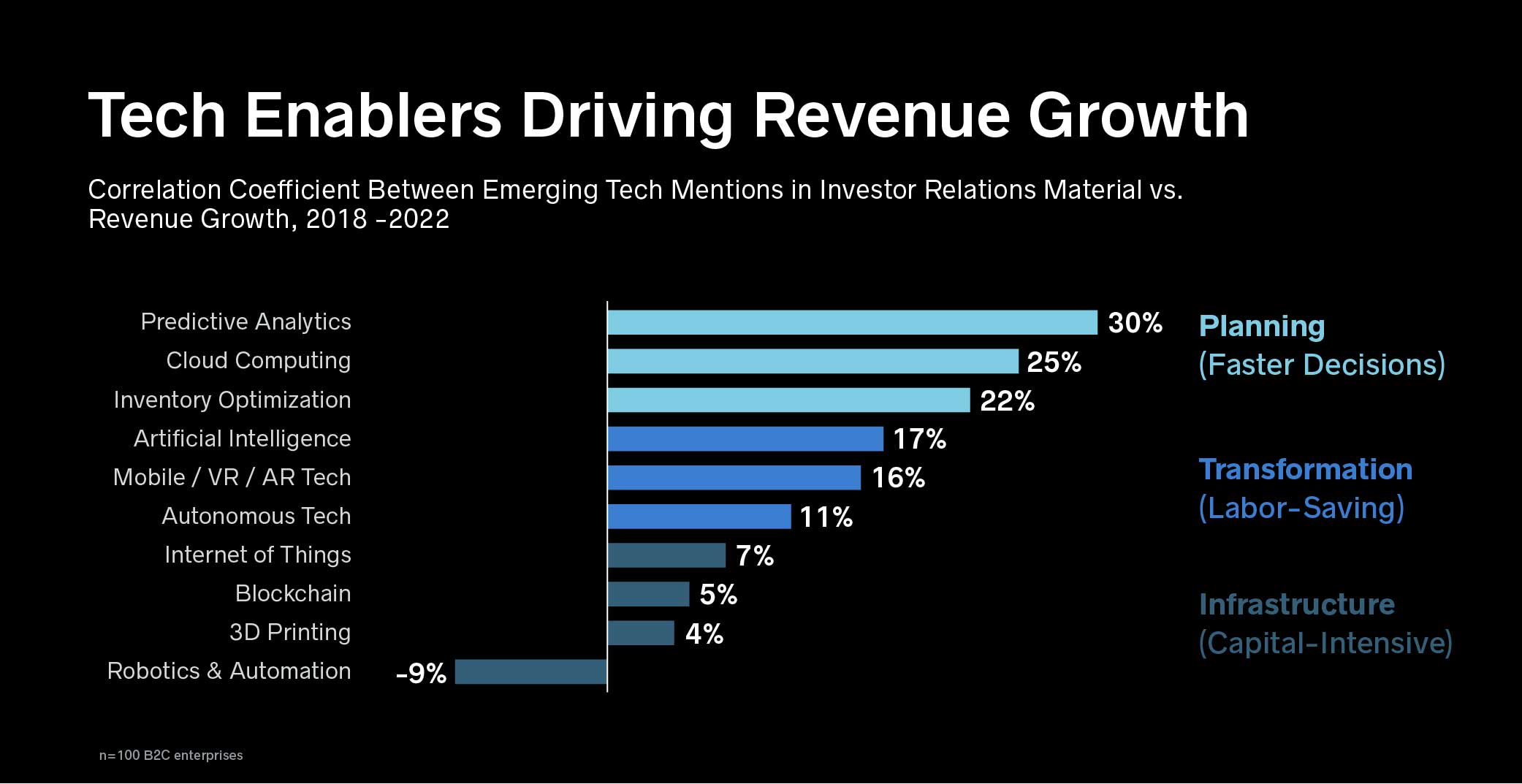
How can consumer goods companies create sustainable success and properly create a roadmap of actionable items?
Whether consumer goods or otherwise, the principles are the same.
The only additional item to consider is non-competitive peer conversations to learn from the wins and mistakes of others. A great way to accelerate learning is to plug into communities of practice that are cross-sector, e.g. a consumer goods company may learn more from a consumer electronics company than one of its direct competitors.
It’s partly why we complement our research with a lot of peer events for C-level supply chain practitioners. It’s about advancing the collective.
Where should IBP leaders be focusing for 2023? What advice do you have for them?
If I could give just one piece of advice, it would be to work back from 5 years out. Deliver rapid value because you need it for momentum. But technology is advancing too fast to leave your long-term technology and associated talent roadmap to chance. And it’s not just the fancy stuff like artificial intelligence you should track. It’s also newer cloud-based data architectures and master data management services that will fundamentally streamline and accelerate the way an IBP process will function. If you limit yourself to a 1- to 3-year vision, you may lock yourself into legacy architectures that block you from real step-function IBP advantage. You want to be the nimble one. That means careful tracking of digital trends. You may not implement all the cutting-edge tools all at once, but you want an architecture that allows you to pivot as new tools emerge. And equally important, you want to build internal skillsets to be able to digest and capitalize on the exceptional technical capabilities that are just around the corner. Deliver value now but be ready for what’s to come.
Learn more: Digital Twins Break Into the Boardroom – Zero Percent Carbon, 100% Digital (zero100.com)
Get the IBP expertise you need to succeed.
There are a lot of ways IBP experts can support your goals this year. Among them, identifying and building upon existing processes, identifying opportunities for improvement and growth, creating roadmaps for success, and providing insight on relevant current events and models. Independent talent are essential assets for companies looking to optimize and standardize supply chain and business processes in all industries thanks to their in-demand skills and niche expertise.
Reach out today to secure insights from Steve Hochman or start a project with another highly skilled independent consultant from Business Talent Group.
GET THE SKILLS YOU NEED
Thousands of independent consultants, subject matter experts, project managers, and interim executives are ready to help address your biggest business opportunities.
Get Started
Previous Article

The rise of high-end, on-demand talent offers professional services firms a better way to think about staff...
Next Article

Explore the top four benefits of independent consulting according to dedicated, full-time independent talen...
Get our free guide to working with on-demand talent.
Most Recent Articles

Each year, the BTG High-End Independent Talent Report reveals the top independent talent trends that executives should know. Learn more about our findings.

New report reveals how leading organizations are leveraging highly skilled, on-demand talent and interim leaders to access critical expertise and navigate a landscape marked marked by constant change.

Herman Vantrappen—strategy advisor and co-author of "The Organization Design Guide"—joins us to discuss the essentials of effective organization design.

Explore what professional authenticity means, why it's important for leaders to create an authentic organizational culture, and how to go about doing so today.

Explore how top companies are helping new leaders succeed by tapping independent talent for executive mentorship and support.

Networking is key for independent consultants who rely on their connections for project opportunities. Try these steps to build your network and deepen your existing connections.

One of today’s top leadership challenges is imposter syndrome. Studies show that this professional plight can affect individuals at all levels of the org—regardless of age or experience—at any...

In the dynamic life science industry, change is vital to maintaining competitive advantage. Start by learning how to best leverage on-demand expertise to yield successful transformations.

Learn more about “liquid talent” models and how this adaptable and dynamic staffing structure is shaping the future of work.

Mal Postings—innovation expert and technology executive—joins us to discuss the impact of artificial intelligence within the healthcare industry.

Tradition tends to bind organizations to outdated methods, even when evidence exists to prove the efficacy of a more modern approach. Often, it’s not until traditional methods become obsolete that lag

Vivek Garg—an intelligent automation and AI expert—joins us to discuss the art of intelligent automation and how advances in artificial intelligence help top companies build and scale savvy solutions.

When a project wraps up, its mission lives on. It’s up to you—and your team—to determine how to build upon the success you’ve achieved. ...

One of the biggest benefits independent talent offer is the ability to seamlessly collaborate with your existing team, but there’s an art to managing blended teams that mix internal with external...

Seemingly overnight, generative AI—or artificial intelligence capable of generating media and data in response to user prompts—became a front-page story and the hottest topic for companies large and

Today’s independents have plenty of choice when it comes to selecting their work. In fact, in competitive, cutting-edge fields like innovation, data science, and supply chain strategy, competition for

When should you bring on an independent professional? Given the challenges companies face to secure in-demand skills and expertise, the short answer is likely: now. The independent marketplace is...

Whether formal or informal, a strategic plan for your consulting practice can go a long way toward positioning you for success in the year ahead.

Whether you need a project manager to oversee a new initiative, an interim executive to lead through a critical time period, or niche expertise to capture a very specific opportunity, engaging

To achieve digital transformation in the insurance industry, leaders will need to look outside their own networks with independent talent.
- Share this Hub

Integrated Business Planning: A Detailed Exploration of Strategy and Execution
✅ All InspiredEconomist articles and guides have been fact-checked and reviewed for accuracy. Please refer to our editorial policy for additional information.
Integrated Business Planning Definition
Integrated business planning is a management process that synergizes sales, marketing, finance, operations, and logistics to drive an aligned operational plan and business strategy, balancing demand and supply while also considering financial objectives and the allocation of critical resources. It embraces short, medium, and long-term business planning and assists in decision-making, reducing risks, and increasing profitability.
Importance of Integrated Business Planning
The crucial role of integrated business planning.
Today’s businesses exist in a world that is, to say the least, complex and full of rapid changes. In these circumstances, integrated business planning plays a pivotal role in navigating through the turbulent times by bridging the gap between the company’s strategic ambitions and their operational constraints.
As a unifying framework, the process provides a link between the top-level strategic planning and day-to-day operational activities. It eliminates silos between departments providing a holistic, transparent and real-time view of the business. By mapping all operations to strategic goals, it ensures that all decisions and actions are pulling in the same direction toward the fulfillment of those goals.
Aligning Strategic, Operational, and Financial Planning
With integrated business planning, synchronization becomes achievable at an elevated level. It enables businesses to align their strategic objectives with operations and finances, thus ensuring a smooth flow of processes. When strategy, operations, and finance harmoniously work together, it eliminates any disconnects, resulting in effective and efficient decision-making.
From a strategic perspective, the approach aids in prioritizing goals and developing responsive and realistic plans to achieve them. On the operations front, it identifies bottlenecks, assesses risk, and ensures that all operations are in line with strategic objectives. Lastly, the integration with financial planning leads to accurate financial forecasts, effective cash management, and robust financial control.
To put it another way, this integrated view of business planning is akin to a well-conducted orchestra. Each section of the orchestra, be it strategic, operational, or financial, knows its role, its tasks, and how it contributes to the overall performance of the melody; which in this case, becomes the successful completion of strategic goals.
The Outcome: A Resilient Business Model
In the face of evolving markets and shifting customer demands, integrated business planning empowers businesses to quickly identify, adapt, and respond to changes efficiently. The approach supports timely and informed decision-making, improves communication and collaboration, and nurtures a proactive business culture focused on future growth.
The process also provides a robust system that facilitates scenario planning and risk mitigation. It promotes informed and rational decision-making, thus creating a resilient business model capable of withstanding market uncertainties and disruptions.
In summary, integrated business planning offers a comprehensive, more intelligent approach to business management—one that aligns strategy, operations, and finance towards a common goal while driving performance and sustainable growth.
Core Components of Integrated Business Planning
At the epicenter of integrated business planning is demand. Understanding current customer needs and predicting future ones is key to running a profitable operation. This involves market research, analysis of historical data and forecasting. By getting an accurate approximation of demand, businesses can take proactive measures to efficiently meet those needs.
Supply Management
It’s not just enough to understand the demand. A business must have a competent supply management system that can meet the anticipated demand. This is achieved by coordinating all elements of procurement, production, and logistics to effectively fulfill customer needs. A successful supply chain management strategy incorporates everything from sourcing raw materials, managing inventory, production planning, to eventual delivery.
Product Management
Product management is a very significant part of integrated business planning. It’s the process by which a business decides what products to offer and how to position them in the market. Product managers work cross-functionally with other teams like marketing, sales, and engineering, to ensure that the product aligns with company goals and customer requirements. They also analyze market trends, competitive landscape, and customer feedback to inform product features and enhancements.
Financial Planning
Lastly, financial planning provides the fiscal framework for integrated business planning. It involves budgeting, revenue projection, expense tracking, and monitoring financial performance against these predictions. A detailed financial plan enables a business to execute its strategies within available resources, capitalize on opportunities and respond timely to market changes. Financial planning is indispensable for a sustainable long-term business growth.
Each of these components works seamlessly with the others in integrated business planning. While demand, product, and supply chain management ensures that the business retains a competitive edge in the market, financial planning provides the necessary oversight to ensure the business remains profitable while doing so. This alignment across all the key functional areas is what makes integrated business planning so critical to the success of a business.

The Role of Integrated Business Planning in Corporate Decision Making
In a dynamic business environment, integrated business planning helps corporations quickly adapt and respond. It operates as a navigational tool, guiding decision-making processes at various levels of an organization, from operational to strategic.
Operational Decision Making
At the operational level, integrated business planning aids in managing immediate and short-term decisions. It provides a detailed view of the current business operations- from sales forecasts, customer demands, supply chain management to available resources.
For instance, consider a rise in demand for a product. An operational decision might involve assessing the production capacity and inventory levels, which integrated business planning can readily provide by unifying data from multiple business functions. This allows the organization to react swiftly and efficiently to unexpected changes.
Tactical Decision Making
Tactical decisions contributing towards achieving short-term goals also benefit from integrated business planning. It aids in providing a firm ground that aligns operational decisions with corporate strategy.
Key functions like marketing campaigns, collaborations, or prodigious investments often hinge on the insights captured through integrated business planning. It not only allows companies to seize up-to-the-minute market opportunities but also helps in mitigating potential risks.
Strategic Decision Making
At a strategic level – where decisions have long-term implications and contribute directly to the achievement of an organization’s mission – integrated business planning is instrumental. It provides organizations with forward-thinking views, predicting future scenarios, and laying out a roadmap to achieve the desired goals.
For instance, making decisions about entering new markets, launching new product lines, or obsoleting older ones are all powered by the insights from integrated business planning.
Thus, integrated business planning is central to decision-making processes, underpinning them with a clear, synchronized view of business functions. It enables corporations to respond effectively and swiftly to business environment changes, maintaining their competitive edge.
Integrated Business Planning and Risk Management
Integrated business planning (IBP) plays a crucial role in managing business risks. It enables organizations to align strategic, operational, and financial plans to achieve overall corporate objectives.
Assessing and Managing Risks with IBP
With IBP, an organization can continually assess potential risks and adjust its plans based on a comprehensive and timely understanding of possible implications. This process reduces the likelihood of sudden impact from unanticipated events and enhances the resilience of the business.
For instance, IBP can help in foreseeing economic downturns and prepare for them by diversifying income streams or increasing savings. Similarly, if a company anticipates a shortage of raw materials, it may use IBP to develop contingency plans such as seeking alternate supply sources, redesigning products, or adjusting manufacturing schedules.
Identifying Opportunities
On the flip side, integrated business planning also plays an essential role in identifying opportunities. This comprehensive approach can uncover potential synergies, efficiencies, and strategic initiatives that would otherwise go unnoticed. Leveraging integrated data, businesses can identify market trends early, allowing them to deploy new solutions or services ahead of their competitors.
Consider an organization that notices an increase in the use of sustainable materials via integrated data analysis. With IBP, the company can assess the possible financial and operational implications of shifting to eco-friendly materials, then devise strategies to capitalize on this trend.
Holistic View of Business Landscape
Furthermore, the holistic view provided by integrated business planning assists businesses with identifying both threats and opportunities. By providing viably comprehensive, cross-functional views of the business landscape, IBP allows companies to anticipate changes, react effectively, and seize the opportunities these changes bring.
In conclusion, integrated business planning’s role in risk management is immense. It promotes resilience by enabling organizations to anticipate potential risks and build strategies to navigate them. It also encourages innovation by highlighting emerging opportunities, leading to improved competitiveness and sustainability.
Tailoring Integrated Business Planning to Different Business Models
Applying integrated business planning (ibp) to service-based businesses.
The successful application of Integrated Business Planning (IBP) in service-based businesses can prove to be unique due to the nature of service delivery and customer expectations. Unlike in a product-oriented business where the primary goal is to manage the supply chain, service-based businesses encounter market variability and require a flexible planning process.
IBP helps these businesses by providing a platform to align their operational plans with strategic goals. For instance, the nature of the service can dictate the planning horizon and the frequency of revising plans. A healthcare provider may need a more immediate planning horizon compared to a consultancy firm due to the unpredictable nature of medical emergencies. Hence, IBP can be tailored to accommodate these different planning horizons.
Adapting IBP for Product-Oriented Businesses
Product-oriented businesses, on the other hand, often have tangible inventory and a visibly structured supply chain. Here, IBP comes in handy to integrate various components like sales, operations, and finance to ensure the business stays on track to achieve its strategic goals.
By synchronizing all critical business units, the company can ensure demand forecast accuracy, reduce stockouts and overstocks, and optimize cash flow. For instance, in a manufacturing business, the use of IBP can be pivotal in decisions ranging from raw material procurement to production planning to order fulfillment.
Implementing IBP in Hybrid Business Models
A hybrid business model, a mix of service and product-oriented business, calls for even more flexible application of IBP. Hybrid businesses need to balance the complexities of both models, and this can be achieved by integrating decisions about service delivery and product supply.
The outcome is a more harmonized strategic plan that accommodatively factors in both the intangible and tangible aspects of the business. For instance, a software company that offers both software products (product-oriented) and software services (service-oriented) may use IBP to synchronize the timeline for product development and service delivery.
In conclusion, while the fundamental elements of IBP remain the same, its implementation can and should be tailored to the unique needs of specific business models. The flexibility of IBP lies in its ability to adapt and accommodate the diverse patterns of businesses, ensuring alignment of strategic goals with operational plans. This is what makes IBP not just an effective planning tool, but an innovative business methodology.
The Relationship between Integrated Business Planning and Corporate Social Responsibility
In the application of integrated business planning, it’s important to consider its impact on a corporation’s social responsibility (CSR) practices. Integrated business planning has direct implications, as it can form a strategic platform for organizations to proactively manage their social and environmental responsibilities, in addition to driving financial performance.
When considering a business’s social and environmental responsibilities, it’s clear that these elements can significantly influence planning processes. This is because businesses, especially those operating in sensitive sectors such as mining or manufacturing, must account for the potential social and environmental impacts of their operations.
Effect on Planning Process
Understanding this, the planning process under an integrated business planning model needs to not only focus on traditional economic factors, but integrate CSR into the heart of their business strategies in a structured and systematic way. This might involve predicting potential social and environmental risks and planning appropriate mitigation strategies, or identifying socio-environmental initiatives and integrating them into the business’s operating model.
Asset Utilization and ESG Compliance
Moreover, integrated business planning can allow businesses to better utilize their assets in the service of both financial objectives and CSR. For instance, a manufacturing facility might plan to use more energy-efficient technologies, demonstrating commitment to environmental sustainability, while also potentially reducing operational cost.
Furthermore, a solid integrated business planning can enhance a company’s efforts in Environmental, Social, and Governance (ESG) compliance. It allows the business to consistently align its operational activities and financial planning with its CSR policies and governance standards. This, in return, may improve the public image, customer trust, and overall market reputation of the company.
Aligning Business Goals with Societal Values
Ultimately, a key aim of integrating CSR into the business planning process is to ensure that an organization’s business goals are well-aligned with societal values and environmental sustainability. Doing so not only helps businesses to fulfill their moral and civic duties, but is also increasingly recognized as a powerful driver of long-term financial performance.
Software Tools for Integrated Business Planning
In order to successfully implement integrated business planning (IBP), businesses need to make use of a variety of software tools. These tools not only make the complex process more manageable, but they also increase accuracy, improve collaborative efforts and provide meaningful insights for better decision-making.
Popular Software Tools
One popular tool is SAP Integrated Business Planning (SAP IBP) . This tool is lauded for its real-time supply chain management features. SAP IBP offers features for demand planning, supply and inventory planning, sales and operations planning, and response and supply control.
Another widely adopted software is Anaplan . Anaplan’s platform helps businesses model and visualize their data, and is known for its capability to handle extremely large data sets, making it ideal for large organizations.
Oracle Demand Management Cloud is also worth mentioning. It provides predictive analytics to understand and manage demand, and it integrates well with other Oracle applications, making it an attractive choice for businesses already using the Oracle ecosystem.
Kinaxis RapidResponse stands out for its scenario planning features, allowing businesses to simulate and compare various situations and their outcomes.
Role of Technology in IBP
Technology plays a pivotal role in IBP, simplifying and enhancing the process. With the vast amount of data businesses deal with today, manually managing such processes would be time-consuming and prone to human errors. Software tools automate most of these tasks, ensuring accuracy and efficiency.
Moreover, these tools often provide data visualization features, converting complex data into easy-to-understand charts and graphs. This not only makes data more accessible to all stakeholders, but also aids in quicker decision-making.
One significant advantage of using these tools is the ability to collaborate in real-time. Multiple users can work together on the same data sets, breaking down silos within the organization. With everyone on the same page, the alignment between different business functions improves, boosts the overall business performance.
Lastly, with features like predictive analytics and scenario planning, businesses can better anticipate future scenarios and prepare accordingly, reducing the risk associated with unforeseen changes in the market or supply chain.
Thus, with the help of software tools, integrated business planning becomes a more streamlined, accurate, and collaborative process.
Implementing Integrated Business Planning
Essential considerations for successful implementation.
To ensure a successful transition to using integrated business planning, several key aspects must be considered.
Employee Training
A central aspect of this change-over is the training of employees. Your employees need to understand the principles of integrated business planning and how they can apply these principles in their day-to-day activities. This training could be delivered through workshops, seminars, or e-courses, depending on what’s most effective for your employees.
Ongoing mentorship and support are also beneficial, helping employees adjust to the new system over time. By providing continuous learning opportunities, you keep your employees engaged and motivated, thus enhancing the adoption of integrated business planning.
Technological Requirements
The transition to integrated business planning is not only about changing mindset, but also about updating your technology stack, as this approach often relies on advanced software solutions. The exact technology needed may vary depending on the scale of your business and the nature of your operations, but a comprehensive business planning software suite is usually a baseline requirement.
Additionally, you would need to evaluate your current IT infrastructure to check if it can support the new systems. It might be necessary to upgrade certain components to ensure seamless operation. Remember, your new software should be user-friendly to promote ease of use among your employees.
Embracing Cultural Change
Implementing integrated business planning can bring about a significant shift in your company culture. As an approach that emphasizes collaboration and transparency, it requires a shift away from organizational silos. Employees at all levels need to get used to sharing information and making collective decisions.
Promoting this cultural shift can be challenging. Clear, effective communication will be crucial. Explain the advantages of the new system, engage employees in the planning process, and make sure everyone understands their responsibilities. Celebrating small victories can also help to promote positive feelings towards the change.
By paying attention to these critical aspects – employee training, technology, and culture change – you can lay the foundation for a smooth transition to integrated business planning.
Share this article with a friend:
About the author.
Inspired Economist
Related posts.

Accounting Close Explained: A Comprehensive Guide to the Process

Accounts Payable Essentials: From Invoice Processing to Payment

Operating Profit Margin: Understanding Corporate Earnings Power

Capital Rationing: How Companies Manage Limited Resources

Licensing Revenue Model: An In-Depth Look at Profit Generation

Operating Income: Understanding its Significance in Business Finance

Cash Flow Statement: Breaking Down Its Importance and Analysis in Finance

Human Capital Management: Understanding the Value of Your Workforce
Leave a comment cancel reply.
Your email address will not be published. Required fields are marked *
Save my name, email, and website in this browser for the next time I comment.
Start typing and press enter to search

Integrated Business Planning: How to Pave Your Way to End-to-end Orchestration
What is integrated business planning, market uncertainties, holistic data analysis, customer centricity, short product life cycles, smaller margins, globalization, being ready for ‘what-if’ scenarios, collaborative and decentralized decision-making, enhanced customer experience, ibp vs s&op: different names for the same process, prioritize the p&l owner, decide on the apt design and cadence, apply consequential thinking to facilitate decision making, support ibp with appropriate technology, a framework for ibp success.
“We plan, God laughs”. True. However, planning is not about knowing the exact outcome. It’s more about gearing up for what-if scenarios, in case something goes awry.
To adapt successfully to evolving market needs and work around economic turbulence businesses need the collective effort of the whole organization — from finance to marketing.
But how can you align the mashup of a company’s strategy, operations, and financial performance? Enter an integrated business planning process.
Once a legacy of Fortune-500 companies, the IBP strategy can be leveraged to transform businesses of all sizes. IBP solutions help both industry giants and young companies manage growth-related risks and help establish disruption-tolerant processes.
An integrated business planning (IBP) process refers to scaling and connecting the planning activities across each business function, silo, and department. Hailed as the enabler of an innovation-ready environment , IBP also syncs business targets, budgets, operations, and business units across the entire organization. At its core, IBP includes technology and applications that connect the planning and operational functions of the company.
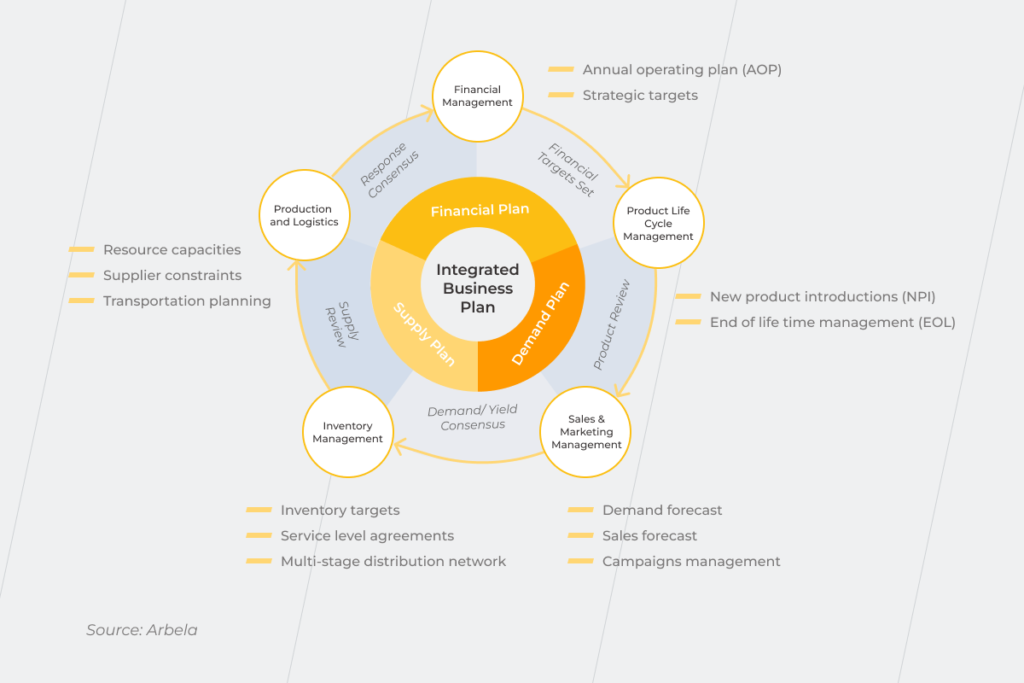
Why put your planning processes in a broader perspective?
According to McKinsey , businesses that have fully integrated business management are in the minority, with only a handful of companies implementing IBP to its fullest. Two-thirds of companies confine unified strategic planning to occasional business reviews.
This means that most companies leave their business decisions to the mercy of siloed planning solutions with limited process visibility and one-sided insights. Conversely, integrated business planning solutions cast their nets wide to deliver value across the entire business and help battle ever-growing business challenges.
In a world of interconnected economies, each company can be affected by the overall market resonance. This is why the pandemic’s disruptions to logistics in China have echoed through global supply chain operations, resulting in a shortage of components. International political uncertainties can reduce the trade openness of a given country, destabilizing the whole world. It means that the success path of a single company depends on a whole lot of political and economic levers involved in internal management.
At least 2.5 quintillion bytes of data are produced every day. However, instead of generating actionable insights, around 95% of companies are unable to make sense of unstructured data — a fundamental building block of business decision-making. The growing amount of big data and its complexity also prevents companies from landing new growth opportunities.
Focus on a customer is a beacon for successful companies and higher profits with over 70% of consumers considering it a basic expectation. However, isolated planning doesn’t factor in all touchpoints. Unable to create a unified customer image, companies struggle to deliver personalized services and initiatives.
Along with granular offerings, customers expect new products to be released faster in regular cycles. However, rolling out new products like a conveyor belt is not enough. To keep up with quickly-changing customer preferences, companies require robust analytical capabilities that consider an entire landscape of opportunities and predict current demand areas.
The world? Volatile, to say the least. Over the last few years, shrinking margins have made a comeback driven by cutthroat competition, market saturation, and inflated costs. Since 2020, margins have been falling down the curve with a negative of at least 0.04% .
As a result, the traditional supply and demand balancing has been rendered ineffective, jolting companies into optimization based on a patchwork of metrics, market trends, and forecasts.
Despite ample opportunities, border-free supply chains have exposed businesses to the ripple effect of global bottlenecks and equipment availability. Differences in standards and regulations, harder planning, and budget constraints require unmatched agility from companies.
To pivot and flex, an organization requires an integrated business planning process flow that eliminates communication lags and steers the whole organization towards its goals despite global instability.
Unmatched benefits of integrated business planning
According to KPMG , integrated business planning best practices stand to increase ROE up to 14 points, reduce costs by up to 10%, and ramp up revenue by 4%. But besides core metrics, what is the true value of IBP solutions?
‘How would the pandemic affect my company? Can I slash the costs to battle the recession?’ Within traditional business management, the answer to your questions is left to guesswork and historical analysis at best.
Paired with robust data analysis , integrated business planning software enables you to simulate the effects of potential actions and changes across the whole organization — from capital expenditures to workforce availability.
You can also mold your growth objective into different market opportunities based on the resources owned or quickly re-allocate the current assets for any transformation with no ad hoc firefighting.
With data sourced across all operations, the decision-making authority is distributed throughout a cross-functional team. Enterprise-wide activation of purpose promotes greater accountability and decision ownership where business units work collaboratively towards a general business goal.
At the same time, consolidated enterprise planning applications eliminate version control and spreadsheet complexity.
It is stated that agility improves customer experience by up to 30 points . A shared purpose and vision embodied across the organization are some of the qualities required to have agility. Besides enterprise adaptability, a bird’s-eye view and corporate alignment deliver a more unified customer image sourced from across the organization. As a result, customers are served more granular messages, desired products with on-time delivery, and customer-centered services.
Make your business future-proof
The difference between S&OP and IBP is challenging to spot as integrated business planning is generally considered an exercise of sales and operations planning. However, an integrated business planning framework makes evidence-based thinking more comprehensive, while S&OP prioritizes supply chain planning as the main benchmark.
Moreover, integrated business planning consultants devise a proactive plan that responds to challenges with the most benefits and least losses, while S&OP is more about satisfying customer needs at all costs.
Below, you’ll find the main differences between IBP and S&OP:
How to create real value? Four pillars of fully integrated business management
According to McKinsey , ineffective consolidated strategic planning is the collective result of three factors. First, if an organization doesn’t include IBP in its regular decision-making process, the added value of unified orchestration tapers off. Secondly, some companies delegate unified planning to junior staff, who, naturally, often lack vision and authority for the function. Lastly, if the executors do not have a single vision of critical decision enablers, they won’t be able to navigate business thinking as a whole.
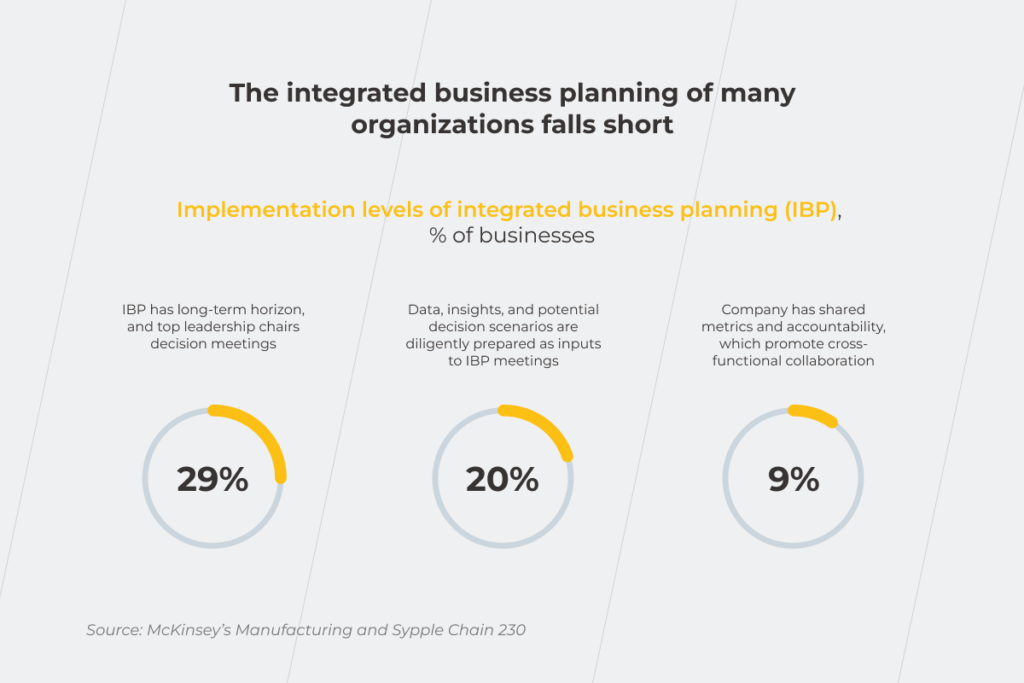
Yet, despite common reasons, there is no ultimate integrated business planning template that caters to all businesses with unique needs. However, some practices can bring your organization closer to the desired outcome of SAP integrated business planning.
In most cases, the owners of P&L at your company have a great read of the existing drivers of revenue and spending. Unlike the supply chain or production management, a P&L-focused integrated process has the most practical requirements based on a broad outlook.
When designing your planning regimen, make sure the groundwork also includes input from upper management so that decisions can be made regularly. This way, the footprint of decisions can be checked against financial thresholds.
At the same time, this business plan allows the P&L owner to align the trade-offs between perils and prospects with the affected area, be it local or global. To unlock this level of visibility, companies should employ robust data governance practices and tools which enable real-time data processing.
To make the most of unified strategizing, companies need to design an IBP flow with a focus on better visibility and critical data sourcing. The main objective of this fit-for-purpose IBP design is to equip the P&L owner with the right output that is clean, standardized, analysis-ready, and can be easily injected into templates. However, even industry-best design practices can fail if the initial input isn’t sifted through an established data infrastructure and effective processing systems.
Adopting the right reviewing rhythm is another salient part of a holistic IBP framework. Analysis-intensive initiatives, such as product releases, should be subject to regular reviews, while urgent issues such as material shortages or insufficient space should be resolved within a weekly agenda.
To facilitate regular feedback loops, companies also need to establish the right technology infrastructure that promotes seamless and real-time communication between business units.
The right integrated business planning example also stimulates an organizational shift within the company. Therefore, when adopting integrated planning, companies should factor in decision-making power, the value of the decision-making variable, and reporting hierarchy as well as giving key stakeholders more authority in the process.
In practice, collaborative and autonomous thinking can be supported with event classification and pre-defined troubleshooting guidelines based on the root cause approach. Also, the autonomous structure should dwell on the scope of operational thinking as well as the escalation mechanism to bring decisions to the appropriate level of responsibility for adequate resolution.
The right technology infrastructure allows each business function to keep its language and still collaborate effectively with each other. Since the operational data becomes paramount in this case, the technology suites have to be easy-to-use interfaces that demonstrate digestible, real-time insights — all within one platform.
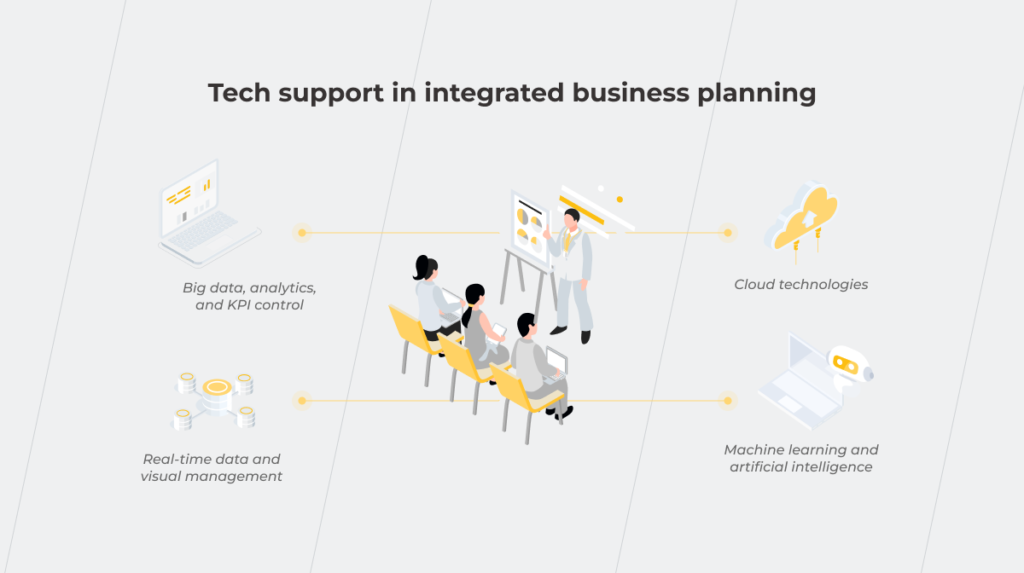
From a technology standpoint, the building blocks of an IBP-friendly ecosystem include but are not limited to:
- Real-time data and visual management
Plotting the business course is impossible without seamless and real-time data flows. To enable collaborative thinking, your tech ecosystem should also support easy integrations among the modules and enable modeling of the supply chain in real time.
- Big data, analytics, and KPI control
KPIs dashboards allow your departments to monitor the performance, report the number of open opportunities, and share insights for other business units. Robust analytics, in turn, allows your dedicated team to drill down into specific metrics and initiate corrective actions for those metrics. Predictive analytics also accelerates your planning by improving assessments of your capacity, generates dynamic forecasts as well as supports scenario planning and optimization.
- Cloud technologies
By moving applications into the cloud , companies can more easily integrate them at a process level. Following a single data model, integrated business planning managers can cover all aspects of planning and arrive at the ‘single number’. Cloud technologies also enable better business continuity and drive down the costs of analytics.
- Machine learning and artificial intelligence
Injected with expert systems, planning systems offer advanced optimization techniques. The latter, in turn, automatically generates replenishment strategies, inventory optimization, and other response measures needed to embrace the volatility of the market. AI-based stress test simulations also help organizations model the scenarios of combined workloads.
A synergy of strategy and execution is what prevents companies from veering off the rails in chaotic times. This synergy is manifested in integrated planning and allows you to create a link between all business operations, uniting them into a cohesive whole driven by the same goal. Unlike traditional S&OP-enabled planning, IBP allows you to go beyond capacity levels and gain a broader foresight of possible business scenarios.
To achieve IBP excellence, you need to look beyond the internal processes and enable visibility into all pivots, from supply chain leaders to customers. Combined with agility, high visibility levels promote business resilience and maximized profits without low-risk exposure.
Data is also the pinnacle of this visibility, making a technology infrastructure critical to IBP success. That’s why the choice of the right technology partner can advance your planning and fine-tune the planning pathways to your unique business needs, making it a critical step in ensuring success.
Looking for the right IBP partner?
Share the article
Topics you may be interested in:.

How to Create a Crypto Payment Gateway: Our Hands-on Experience

Business Process Transformation: The Ultimate Guide on Accelerating Out of Crisis

Top Software Development Trends Of 2021

“We pull our socks up and handle the chaos”: Alexey Spas on a new delivery methodology

How *instinctools delivers solutions – customers’ reviews

Automated downfall check for the code. Quick SQL-injections search

Freelancers. A blessing or a curse? How to work with freelancers?

Who could be saved from the Titanic of IT business?
Get in touch

Integrated Business Planning – Introduction, Overview, and Current Best Practice
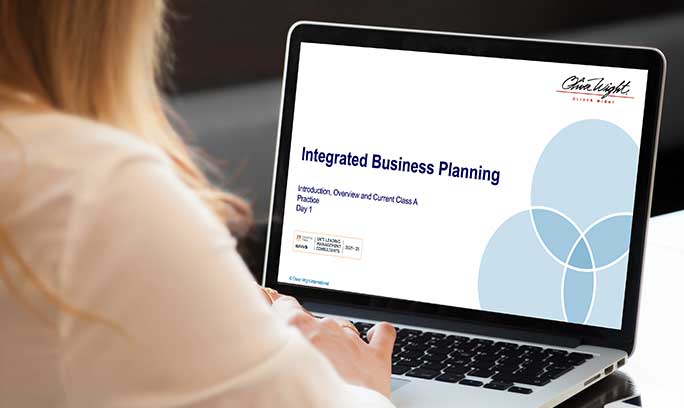
Select a course date for times.
Promotional Codes
Register and pay 60 days prior to the workshop for a 20% discount
Use Code: EARLYBIRD
Book three places at the same IBP workshop and pay just £1,595 + VAT
Use Code: TEAM3
Book two places at the same IBP workshop and pay just £1,195 + VAT
Use Code: TEAM2
Please note: only one code per transaction
Related topics
- Integrated Business Planning
Integrated Business Planning (IBP) remains a critical enabler of business success for many leading organizations, and continues to ensure alignment and focus to respond to a changing world.
Why should an organization invest in IBP?
In this uncertain world, it is vital that executive and general management teams in your business are able to anticipate change early, understand key implications, and make timely decisions to ensure you stay ahead of the competition and keep your organization securely on track.
But for IBP to drive real success in your business, education and knowledge must cascade its way throughout the entire organization. That’s why this workshop has been designed not only for leaders but for those who engage with them. Unforeseen events can be detected early and addressed with speed and agility through planned actions rather than fire-fighting. Which means you’ll always remain on course to achieve your business goals.
You should consider this workshop if:
- You are struggling to align your organization in an ever-changing world and/or are caught up in a cycle of firefighting and inefficiency.
- You keep missing budgets and forecasts yet spend a lot of time preparing plans nobody believes.
- You are caught in a siloed organization with functional or ineffective decision-making.
- You have been introduced to IBP (either by Oliver Wight or your own research) and want to learn more about the process and how to deliver success for your organization and industry.
- You are an organization running an S&OP/IBP process already and feel that it is not delivering the results you expect.
- You are an organization using IBP and are part of the process. You want to learn how to support the process more effectively.
- You are an organization considering a major tool investment to support IBP but need to be sure that you are taking the right approach.
Who should attend?
- Executives and business leaders who have been introduced to IBP and want to learn more about how it can work in their organization.
- Decision-makers who are thinking about implementing IBP either as a process or a tool journey.
- Smaller organizations who are not ready for a full program but are considering implementing IBP.
- Managers who are in a business running IBP/S&OP today and want to understand best practices to better execute their roles.
- Key stakeholders in businesses who are running or implementing IBP today with Oliver Wight as implementation partners either in the past or present, who require IBP introductory education.
Workshop overview
During this workshop, you will learn from Oliver Wight - the originators and thought leaders of IBP - about how it works and how it can deliver success.
Combining process foundations with practical insights, this workshop will be valuable for organizations considering implementing IBP, as well as leaders and process owners involved in delivering IBP in their organizations today.
During the workshop your instructor will
- Introduce IBP as a formal management process of choice, regardless of business and sector, and explain the benefits it should deliver.
- Describe the way IBP aligns the modern organization from planning to financial and matrix integration, and ensures focused decision-making to deliver the strategy and close gaps between ambition and reality.
- Cover the core components of modern IBP – Portfolio, Demand, and Supply Chain Management – both from a process and focus perspective.
- Explain the critical requirements, including process, roles, measures, and reviews, and the importance of integrated reconciliation, financial integration, IBP facilitation, and the executive Management Business Review.
- Cover the challenges and requirements to support the implementation change journey, including process and tool integration.
Workshop objectives and expected outcomes
After completing this one-day workshop you will:
- Gain clarity on what IBP looks like and how it is designed to deliver excellence to modern organizations regardless of industry or sector.
- Understand the foundational principles that support IBP success and how IBP potentially challenges some of the embedded norms and behaviors in your organization.
- Learn practical knowledge about key process components, what is required to make them work, and the ability to understand the gap between the process and what you are doing today.
- Understand how IBP is evolving and why it is more relevant than ever for the modern organization in a changing world, with evolving thought leadership in key areas.
- Have visibility of the challenges that drive IBP implementations and understand why it is important to focus on behavior and process in the right way to ensure success.
- Learn from practical examples and references from the Oliver Wight presenters, using their experience to guide your journey and challenges, whilst networking with other delegates.
Upcoming courses
Over 70 fortune 500 companies have trusted Oliver Wight to help them understand their business needs. See what a few of our clients have said. Our primary objective has always been to be our clients’ most trusted external advisor. The quality of our people is the cornerstone of our ability to serve our clients.
"So far, we estimate that process improvements and efficiencies have delivered savings of approximately €2 million." Doctor Egiziano Iencinella Supply Chain Director
“Really concise overview of the whole IBP process – perfect for Executives to understand the process, and for others to refresh their memory on some of the key principles." Mike Higgins Head of European Logistics
“Mind blowing and educational. This workshop clearly defines the strategy and vision of what IBP will bring!” Planning and Logistics Manager Industrial Engineering Organisation
Technologies
More insights for you, the 50 best oracle certifications.
- Argano 4 Microsoft
- Argano 4 Oracle
- Argano 4 Salesforce
- Argano 4 SAP
- ArganoConnect
The right foundations changes everything
- Founders Club
Alliances & Partnerships
- Customer Experience
- Commerce Solutions and Services
- Revenue Operations
- Human Capital Management
- Supply Chain Management
- Enterprise Resource Planning
- Enterprise Performance Management
- Change Management
- Cloud Migration
- Data & Analytics
- Implementation
- Integration
- Managed Services & Support
- Program Management
- Strategy & Consulting
- Training & Education
- Engineering & Construction
- Financial Services
- Healthcare & Life Science
- High Tech & Telecom
- Manufacturing
- Retail | Distribution
- Alliances and Partnerships
- Thought Leadership
- Client Stories
- Why work at Argano?
- Open Positions
- Linkedin Created with Sketch.
Made for you
What is integrated business planning (ibp), and why is it important.

There’s nothing that can bring a business to grinding halt faster than lack of collaboration between different departments and poor visibility of processes within and between departments.
But creating a business plan that integrates all aspects of your organization can be challenging as each business process is often measured by its own, unique set of metrics, and some are more important than others, depending on which department is “running the metrics.”
For instance, while the demand forecast accuracy is a top priority for your supply chain managers, your procurement department may be more interested in reducing the price of raw materials, and your manufacturing division might aim to maximize its capacity utilization. Organizations with inconsistent planning practices risk running inefficiently, which can result in a substantial loss of time, energy, and money.
So, how do you align the many strategies, operations and functions from each of your departments to make informed decisions about market policies, investments, and even new product or service introductions?
One widespread method that is used to connect diverse business strategies is Integrated Business Planning (IBP). Developing and implementing an integrated business plan for your organization gives you a clearer understanding of your goals and how to plan to achieve them.
What is Integrated Business Planning (IBP)?
Companies have multiple operational functions – ranging from finance to supply chain, to product design and development, to marketing and sales, ad infinitum. By using IBP, you can link your strategic plans and be more aware of how resources, capabilities, and results relate to one another. This enables you to reach your maximum potential and enhance collaboration across supply chains.
With digitization driving success, IBP is becoming a “best practice” tool for business planning. From sales to operations to finance, data from every facet of an organization can be incorporated seamlessly. This method of incorporation allows companies to maximize output and understand how their resources, abilities, and outcomes are all working together. It also helps companies analyze what role each sector plays in the business.
Why Is Integrated Business Planning Important?
How can your business benefit from integrated business planning? Let’s take a look at a few benefits:
- Increasing visibility Organizations can integrate data from financial reports, supply chain projections, and strategic plans into their business plans using IBP. By doing so, businesses gain insights into how each part of the supply chain works both independently and collectively. As a result, it enables businesses to discover and resolve problems in an efficient manner.
- Increasing accountability With more visibility, employees are more plugged in and aware of the impact their actions can have on the business as a whole. This makes them more accountable and provides a clear understanding of exactly what their responsibilities are, which increases employee engagement and boosts compliance with processes and procedures.
- Aligning goals and actions An organization with visibility and accountability can get a clearer picture of what it is striving for and helps to ensure that everyone is taking the necessary steps to achieve it. In addition to enabling individuals to do their jobs more effectively, this will also allow the whole organization to run more efficiently.
- Allowing for better decision making An integrated business process enhances a company’s ability to evaluate data, the relevant context, and the big picture at the same time. By analyzing the results, they can make highly informed decisions based on the information they are presented with.
These benefits are desirable for any organization, but implementing integrated business planning successfully can be a complex process. Following best practices for IBP increases your odds of success and improves your outcomes.
Tips and Best Practices for Successful Integrated Business Planning
IBP is potentially valuable for your business. However, when you try to integrate additional functions and strategic planning into your traditional sales and operations planning (S&OP) cycle, it can initially lead to many challenges. Let’s take a look at a few tips for successful integrated business planning.
- Effective governance To make an IBP work, everyone needs to work together as a team and fulfil the company’s objective. Charting the roles and responsibilities of your employees and implementing policies and incentives to create an environment where everyone can work together can help improve team cohesion.
- Clear goal Start with a clear goal for implementing an IBP and how it will benefit your business (and individual contributors).
- Organized process When your process is already designed to align with your organization, it is easier to achieve the desired outcome.
- Right talent The backbone of an organization is its workforce. Choose your employees wisely; look for the skills, experience, and core competencies that are vital to IBP. You’ll need team members who are well-versed in strategic planning, financial planning, and supply chain planning. You will be able to more successfully adopt IBP across the company if you have talented and experienced people on board.
- Insightful analytics Businesses need to be proactive to remain ahead in their respective markets. Real-time analytics enables you to adapt swiftly to disruptions and market changes and make data-driven decisions based on your business strategy.
- Powerful technology Businesses are moving ahead with digital transformation. IBP, being a cross-functional initiative, needs a strong cloud-based technology platform to perform.
IBP has become an integral element of the day-to-day operations of many businesses, ensuring transparency and efficiency throughout the fast-paced supply chain right from procurement through manufacturing and delivery. As an increasing number of companies make the shift to digitization, the implementation of an integrated business planning (IBP) approach is vital.
Other articles you might enjoy

AI's Impact on Demand and Supply Synchronization: Is it a...

Navigating the Data Seas: Exploring AI's Influence on Data...

The Brain of Every Business: Introducing High-Performance...

Automating Incentive Compensation Plans

Digital transformation at the intersection of operations and technology
Subscribe for insights and updates
Copyright ©2024 Argano

Drive your Business with Integrated Business Planning
Integrated Business Planning is the next step of business planning after implementing S&OP, which helps integrate all the different departments in the planning process. This helps in aligning every department and employee of the company to work towards attaining a single goal. Home > Insight > Drive your Business with Integrated Business Planning
The business planning process is essential to running a successful business. Earlier, the business planning strategies across the supply chain were disjointed, as disparate spreadsheets and standalone business intelligence solutions provided limited knowledge, due to which companies lacked unification across the entire organization. Due to a lack of interdepartmental synchronization between the planning of the activities that impact the financial bottom line, silos were created, leading to more resource utilization and less productivity.
The traditional business planning process lacks a collaborative approach, and hence there was no accountability for overall results; every division focused on their activities rather than considering a part of one business team. Integrated business planning was introduced to overcome the problems of traditional business planning. The organization uses that to create an agreed dependable market plan to which every department has contributed.
Table of Contents
- Similarities between IBP and S&OP
- IBP vs S&OP
- Users of Integrated Business Planning
- Working Mechanism of the IBP Process
- IBP Challenges
- Significance of Integrated Business Planning
- Seeking Assistance with IBP Software
What is Integrated Business Planning (IBP)?
Integrated Business Planning (IBP) is the business planning process that uses financial and operational data from across the organization. In other words, IBP is an amalgamation of supply chain management, financial planning, and operational best practices. One of the primary benefits of integrated business planning is optimized output by linking strategic plans with sales, operations, and finances to provide better visibility of the relationships between results, resources, and capabilities. It aligns business goals and financial targets with decisions and execution across the entire business. Since this planning gathers data from across the enterprise, organizations are better at predictive analysis. Thus, if the analysis forecasts a parts shortage, supply and operations adjust and prevent customers from getting affected.

Most of the time, the argument arises that IBP is just an extended form of S&OP that includes finances and operations. While there are some similarities between IBP and S&OP, it is wrong to say that IBP is an extension of S&OP. Let’s discuss it further.
Regarding the similarities between IBP and S&OP, both processes need extensive supporting data to make correct forecasts. Both align forecasts with the capabilities, and both techniques help senior management make the right planning decisions. While there are similarities between IBO and S&OP, there are certain things that cannot be attained through S&OP alone, and to bridge that gap, IBP is used.
One of the significant differences between IBP and S&OP is that IBP aligns the different departments of an organization towards a single goal. IBP measures the performance in terms of finances, which helps in planning the business activities according to the financial target of the organization. S&OP tends to focus on medium-term planning targets, whereas the IBP process supports long-term, short-term and medium-term strategies.
Who uses Integrated Business Planning?
Integrated business planning is ideal for any company to improve the forecast through IBS, maximize profits and reduce the risks associated with the company’s growth. Companies that adopt this planning obtain several practical benefits, such as reduced holding costs, proactive customer service, demand fulfillment, less time to market for new products, and better collaboration between demand planning and completion. It makes planning and operations more transparent. Thus, companies moving to just-in-time manufacturing find it ideal. IBP is also predictive, so once the company builds up some data, it will improve customer satisfaction. Seeing the future of IBP is expected to help companies to work on strategy planning, modeling, and M&A activities with great confidence. It will also allow companies to inform stakeholders of unanticipated events that affect the business using advanced technologies like machine learning pattern recognition.
How does the IBP Process Work?

There are mainly six steps towards integrated business planning process flow.
- Determining Business Hindrances The first step in Integrated Business Planning is determining the business hindrances holding the company back. It can be a lack of growth and profitability, a complex product portfolio, or a loss of competitiveness. Proper planning and implementation are only possible after identifying the problem.
- Employee Education Once the problem is identified and goals are set, the goals must be effectively communicated to the employees at different ranks. Unless everyone is aware of the goals set by Integrated Business Planning, attaining the business goals is not possible. Companies must organize employee engagement programs to educate employees about the company goal and keep them invested in the business’s success.
What are the Challenges of Integrated Business Planning?
Once the company has appropriately implemented the S&OP processes, the next step is to implement integrated business planning, where the finance is integrated with all other departments involved in planning. Integrating finance may sound like a simple task, but it is not easy. A major challenge companies face while implementing the components of IBP is interdepartmental communication about the IBP elements and their importance. People involved in the physical side of the supply chain use a different form of language than that used by the finance people. Mostly, supply chain people talk in terms of units, product groups, and products, whereas finance people talk in terms of currency and money. This results in different KPIs used for measuring performance, creating a silo-like situation among the departments.
Other than that, communicating the goals with every company employee and maintaining the same motivation to reach that goal is another major challenge for the company management.
When a company adopts integrated business planning to improve forecasts and enhance productivity, there are some risks the company must be aware of. Below are some of the pitfalls that companies need to avoid while implementing IBP.
- All department employees do not share the same level of commitment to achieving the financial goals set by the IBP process.
- Business planning is a step-by-step process. First, companies must ensure that the S&OP process is properly implemented and stable in the business processes. Without S&OP, implementing IBP is a huge step.
- Targets and forecasts may get mixed up and take the business process off track.
- Unavailability of proper data and information is one of the biggest causes of failure of IBP.
- Discussing only short-term goals and ignoring midterm goals and assumptions can reduce the efficacy of the IBP process.
- A lack of thorough understanding of trade-offs can lead to misunderstanding between departments leading to lagging operations.
- Not using Integrated Business planning solutions such as AI/ML-based software applications for decision making.
What is the significance of Integrated Business Planning?
Research revealed that the major impacts of implementing integrated business planning are increased revenue, accurate forecast, and improved order delivery rates which signify the importance of IBP. Besides, there are several other factors of integrated business planning that ensure better performances across the business; some of the factors are discussed below:
- The primary feature of IBP is that companies buy the correct quantity of materials at the right time and at the best price to cater to market demand.
- Successful IBP also ensures more trust and better collaboration among departments, further leading to improved decision-making.
- Companies that adopt IBP have a direct line from purchasing, production, and inventory to sales and marketing, budgets, and financial targets.
- With IBP, companies can align supply chain projections, financial projects, and strategic plans into one strategy.
- With better visibility across all business departments, decision-makers can devise a single plan to drive the integrated business planning objective.
- With IBP in place, companies can easily focus on making an informed decision and reduce decision latency.
Looking for help in Integrated Business Planning Software?
As we discussed earlier, incorporating technology is the best way to consolidate and analyze big chunks of data more accurately and implement integrated business planning more efficiently. As advanced analytics technologies such as Artificial Intelligence have evolved and have been out of the lab, they are helping businesses in various ways. The benefits of using AI in business planning are proven by customer behavior analysis or business operation automation. At 3SC, we provide integrated business planning consulting services and supply chain management solutions tailor-made for businesses. We analyze the challenges faced by supply chains of different industries and find solutions to those challenges that can make business processes smooth and seamless. Our comprehensive AI/ML-based solutions, such as Visilog and Carbonex, not only optimize supply chain management and business planning but also help reduce businesses' carbon footprint and promote environmental sustainability in business.
What are the applications of Integrated Business Planning?
The application of integrated business planning makes operation and planning in different departments in a company more transparent which helps in better forecasting and implementation of data to ensure better customer satisfaction and lower business costs.
What are integrated business planning examples?
One prominent example of integrated business planning is the Uponor Group, which implemented IBP and brought down the number of SKUs from 120,000 to 10,000, bringing down the inventory costs by 50% and a 30% increase in one-time in-deliveries.
Another US-based technology company, Juniper Networks, implemented IBP, which helped them attain 55% lead time and reduce inventory costs by 15%.
What is an integrated planning tool?
An integrated business planning tool is an AI-based software that collects big chunks of data from different departments, analyzes it, and gives demand forecasts that help in the seamless and efficient planning of business processes.

Get In Touch
Thank you for contacting us. Our executive will get back to you shortly.
Subscribe to our newsletter
Thank you for subscribing to our newsletter. Stay updated with supply chain industry insights with our weekly newsletter.
Take a Peek At Our Solutions
Thank you for showing interest in our products. Our Executive will contact you soon with the details of your requested demo.
- my. Inchainge
- Integrated Business Planning
What is Integrated Business Planning (IBP)? And what are the similarities, but also differences when compared to S&OP? In this article, Inchainge discusses everything you need to know about IBP.
What is integrated business planning (IBP)?
Integrated Business Planning (IBP) is the business planning process that extends the principles of Sales and Operations Planning (S&OP) throughout the value chain . It is to create a bridge between strategy and execution. IBP is a next step for companies that already have an S&OP process in place. It is a next step because it integrates the Financial Planning Cycle. The financial function will become part of this cross-functional process. In most companies the business owner of this process will change as well.
Similarities between IBP and S&OP
Integrated Business Planning and Sales and Operations Planning have several similarities between them. These are as follows:
- Monthly process
- Cross-functional approach
- Driven by business strategy
- Tactical planning at an aggregated level
Differences between IBP and S&OP
However, Integrated Business Planning includes content on top of Sales and Operations Planning:
- Financial function involved
- Integration financial planning cycle, like financial budget and forecast
- From volume planning to volume and value planning
- It drives the overall business performance
How does the IBP process work?
Companies have an annual budget cycle, based on their strategic plans and targets. The annual budget projects planned revenues and costs for the year.
In traditional S&OP companies go through a monthly process during which they project for the next 6 to 24 months where demand will go, and what resources need to be available to meet that demand. When gaps are discovered between expected demand and available resources looking this far ahead into the future, this often provides ample time to balance supply and demand, so that by the time real customer orders are submitted, demand can be met.
Suppose that during this monthly S&OP cycle, one would also look 6 to 24 months into the future where expected revenues and costs will go. And how these financial figures would look compared to the annually budgeted revenues and cost. Most likely gaps will occur here as well between the annually budgeted numbers and the monthly updated numbers. Actions could then be taken to address these gaps. Integrating a financial view. When this happens, we actually practice IBP. In IBP the relationship with the financial performance management cycle is very important. Budget and financial forecasting must be aligned and integrated with the steps from the original S&OP cycle.
The challenges of IBP
IBP is a next step in maturity after companies have implemented a proper S&OP process. Integrating finance sounds simple but is not easy at all. People from the physical supply chain side of the business, often speak a different language than people who operate on the financial side. Supply chain people often speak about units, products, and product families, whereas financial people often speak about money, currencies, etc. That also causes both functional areas to be assessed differently with the KPIs that they use. This calls for other participants in the IBP process, compared to participants in the S&OP process.
The 8 common pitfalls when implementing IBP
Be aware of the following risks related to integrated business planning:
- Lack of commitment in some of the needed departments
- If the S&OP process was not yet implemented or stable, IBP is too big of a step
- Targets and forecasts are mixed
- Information not available
- Discussion about numbers instead of the underlying assumptions
- Discussing only short horizon instead of midterm
- Too granular plans and discussions
- Thorough understanding of trade-offs is lacking
Want to know more? Experience IBP!
Because IBP is simple but not easy, a real-life experience creates enormous value for learning about this topic. The participants will feel and recognize the important issues in this process. In our business simulation game, The Cool Connection , we have incorporated the most important functions and decisions.
In this business game the team is forced to make a yearly financial budget and quarterly forecasts. The objective is to close the gaps between prediction (the budget and forecasts) on one hand and attained performance on the other. The best performing teams are both profitable and predictable at the same time. In business game The Cool Connection the team is almost experiencing a real-life IBP process.
Besides our business games, you can learn more in our articles about topics such as Total Cost of Ownership (TCO) , strategic alignment and external alignment and collaboration .
Now you know
Now you know that IBP is a next step for companies that already have an S&OP process in place, by integrating the financial planning cycle in this cross-functional process. IBP prompts companies to include planned revenues and costs in their annual budget cycle. Budget and financial forecasting must be aligned and integrated with the steps from the original S&OP cycle. Integrating finance sounds simple but is not easy at all. Supply chain people and finance people tend to speak a different language. Make sure to be aware of the 8 common pitfalls when implementing IBP.
You might want to learn more about

Learning is the process of acquiring new understanding, knowledge, behaviors, skills, values, attitudes, and preferences. There are many ways to learn but what works best? And why does it matter? In this article, Inchainge discusses everything you need to know about learning.

The Cool Connection
The Cool Connection is an innovative web-based business simulation game. It engages participants in making strategic decisions in the management of a manufacturing company of personal care products. Working in teams of four, participants will represent the functional roles of sales, purchasing, supply chain management and finance. They will be confronted with various real-life, real-time dilemmas.

- Total Cost of Ownership
When buying new equipment, the price tag only tells you part of the story. Energy costs, maintenance, and repair fees are often several times higher than the initial price! But often these are left unconsidered and hold nasty surprises further down the line. Calculating the Total Cost of Ownership is an important step when planning new investments.

- Strategic Alignment
Understanding what strategic alignment really is and why it is important can make the difference between being a successful company and failing. Due to its complexity, the supply chain often faces challenges in aligning its strategy properly and working as one. In this article, Inchainge discusses everything you need to know about strategic alignment.

- External Alignment and Collaboration
In an increasingly global and connected world, companies rarely execute supply chain operations themselves, but must outsource certain tasks. To make sure that supply chains across several companies run smoothly, external alignment is essential. In this article, we’ll discuss everything you need to know about external alignment.
Dive into our knowledge base
- Key Performance Indicators
- Sales & Operations Planning
- Blended learning
- Delivery formats and scalability
- Experiential learning
- Flipped classroom
- Learning cycle
- Soft skills
- Building (virtual) teams
- Leadership skills
Supply chain
- Data analytics
- End-to-end Supply Chain Management
- LARG Supply Chain
- Logistics footprint
- Omnichannel
- Supply Chain
- Supply Chain Finance
- Supply Chain Management
- Supply Chain Risk management
- Supply Chain Volatility
- The Bullwhip Effect
- Sustainability
- Carbon footprint
- Circular Economy
- Does Green Governance drive the ride to a sustainable future?
- Everything You Need To Know About Eco-Efficiency
- Greenwashing: Everything you need to know
- Is it possible to measure the Triple Bottom Line?
- Sustainability v/s Circularity
- The 3Ps Series: People
- The 3Ps Series: Planet
- The 3Ps Series: Prosperity
- The Butterfly Diagram
- The Value Hill
- What are the 3Ps of Sustainability?
- What do we know about the Triple Bottom Line?
- Value Chain
Privacy Overview
SAP Best Practices for SAP IBP
After completing this lesson, you will be able to:
- Leverage SAP Best Practices for SAP IBP
The tool to access the SAP Best Practices content up from SAP IBP 2305 is SAP Signavio Process Navigator. SAP Best Practices for SAP IBP will be updated and enhanced every quarter and gives you everything you need to run Planning processes in the following applications:
- SAP IBP for sales and operations
- SAP IBP for response and supply
- SAP IBP for demand
- SAP IBP for inventory
- SAP IBP for demand-driven replenishment
- SAP Supply Chain Control Tower
All scope items are based on a comprehensive data model, which enables you to execute an integrated, end-to-end business process. SAP Best Practices comprises Planning View templates for interactive simulations and what-if analyses, predefined dashboards for embedded analytics, alert definitions for exception-based Planning, integration for context-aware social collaboration, and sample data to showcase the end-to-end process.
Business Benefits
- Reduce Sales and Operations Planning costs
- Improve demand forecast accuracy and react more quickly to changes in demand
- Increase sales forecast accuracy
- Reduce inventory carrying costs and increase inventory turnover/reduce days in inventory
- Improve on-time delivery performance
- Increase revenue and reduce revenue loss due to stock-outs
- Increase user productivity by using Microsoft Excel for interactive Planning and by integrating social collaboration
Important covered Process Steps
- Detailed configuration documentation for setting up predefined SAP Best Practices processes
- Predefined Planning Views in Microsoft Excel
- Predefined charts and dashboards to analyze trends and exceptions
- Predefined process management to track progress and integration into social collaboration
- Based on integrated Planning areas, allowing you to operate and end-to-end process across all SAP IBP applications
You can use the unified Planning area (SAPIBP1) to jump-start the implementation in case your business process requires integration across different SAP IBP applications. The unified Planning area is a comprehensive sample Planning area that supports an integrated Planning process covering all of the applications listed above. Just like any other sample Planning area, this Planning area delivers an out-of-the-box integration scenario, which you can customize to fit your unique requirements.
For the integrated Planning process based on the unified Planning area, the SAP Best Practices for SAP IBP provides sample data, Planning View templates, predefined dashboards, configuration guides, test scripts and more. Customer test tenants and SAP Integrated Business Planning for Supply Chain, starter edition instances include an activated copy of the unified Planning area with sample content.


IMAGES
VIDEO
COMMENTS
In our experience, integrated business planning can help a business succeed in a sustainable way if three conditions are met. First, the process must be designed for the P&L owner, not individual functions in the business. Second, processes are built for purpose, not from generic best-practice templates. Finally, the people involved in the ...
March 16, 2021. Think of modern integrated business planning, or IBP, as a mashup of supply chain optimization, financial planning and analysis (FP&A) and operational best practices, powered by a companywide culture that's all about delivering the speed, savings and responsiveness today's consumers demand while managing risk.
Integrated business planning framework. Integrated Business Planning (IBP) is a holistic approach that integrates strategic planning, operational planning, and financial planning within an organization. IBP brings together various functions, including sales, marketing, finance, supply chain, human resources, IT and beyond to collaborate across ...
Integrated Business Planning is a cutting edge process which creates cross-functional alignment and enables businesses to re-focus to meet the ever-changing environment. ... Overview, and Current Best Practice. More information + 10 Sep 2024. Virtual (English) Integrated Business Planning - Introduction, Overview, and Current Best Practice ...
Benefits of Integrated Business Planning When you're looking for IBP best practices, a great place to begin is by taking advice from experts like Ken Caron and Ken Olsen of Deloitte. In a webinar (now available on demand), they shared their definition of IBP, discussed some core ideas behind it , and described how you can kick-start your ...
Integrated business planning is a process that continuously aligns targets, assumptions, and plans across all key players in a company to assure more reliable achievement of business plans and brand objectives. In plain English, it's a way to get everyone on the same page, fast, and execute. IBP emerged in the early 2000s because of a very ...
Integrated business planning is a management process that synergizes sales, marketing, finance, operations, and logistics to drive an aligned operational plan and business strategy, balancing demand and supply while also considering financial objectives and the allocation of critical resources. It embraces short, medium, and long-term business ...
Align and synchronize your strategic and tactical planning, including S&OP, annual operations, and financial and strategic business planning. IBP should encompass strategic plans, initiatives, activities, and regional and multidivisional operational plans. Perform fast simulations, comparisons and what-if scenarios.
An integrated business planning (IBP) process refers to scaling and connecting the planning activities across each business function, silo, and department. ... According to KPMG, integrated business planning best practices stand to increase ROE up to 14 points, reduce costs by up to 10%, and ramp up revenue by 4%. But besides core metrics, what ...
Select Course. 12 Nov 24. Integrated Business Planning - Introduction, Overview, and Current Best Practice. 4.5 (88) £795.00. Select Course. Our clients love what we do. Over 70 fortune 500 companies have trusted Oliver Wight to help them understand their business needs. See what a few of our clients have said.
By using IBP, you can link your strategic plans and be more aware of how resources, capabilities, and results relate to one another. This enables you to reach your maximum potential and enhance collaboration across supply chains. With digitization driving success, IBP is becoming a "best practice" tool for business planning.
3:57. Integrated Business Planning is a best-practice process that aligns Commercial, Financial and Supply Chain activities. In doing so, they are performed as coordinated business decisions with the intent to deliver increased revenue, improved service levels, reduced supply chain costs, greater productivity, better cash flow and higher profits.
3. Align processes and systems. Align your processes and systems to support IBP effectively. This includes integrating data sources, defining workflows and ensuring that technology infrastructure ...
Integrated Business Planning (IBP) is the business planning process that uses financial and operational data from across the organization. In other words, IBP is an amalgamation of supply chain management, financial planning, and operational best practices. One of the primary benefits of integrated business planning is optimized output by ...
Integrated Business Planning (IBP) is the business planning process that extends the principles of Sales and Operations Planning (S&OP) throughout the value chain. It is to create a bridge between strategy and execution. IBP is a next step for companies that already have an S&OP process in place. It is a next step because it integrates the ...
SAP Integrated Business Planning (SAP IBP) is a comprehensive solution that helps businesses streamline their planning processes and improve decision-making. In this blog post, we will explore the recent enhancements and new features introduced in the SAPIBP1 sample planning area and the addition of new solution processes in SAP Best Practices ...
10-27-20238:19 AM. 2 Kudos. SAP Integrated Business Planning for Supply Chain 2311 comes with great enhancements, and so the SAP Best Practices for IBP does. Let's take a look at the main topics: Enhancements and changes for Sample Model SAPIBP1 As you might know, we update and enhance the sample planning area SAPIBP1 in every release.
10-31-2022 8:00 AM. The 2211 version of SAP Best Practices for SAP Integrated Business Planning for Supply Chain is now available. As always full of valuable business content, enhancements and simplifications. If you read this blog series on a regular base, you know that I start usually with the changes for the sample planning area SAPIBP1.
All scope items are based on a comprehensive data model, which enables you to execute an integrated, end-to-end business process. SAP Best Practices comprises Planning View templates for interactive simulations and what-if analyses, predefined dashboards for embedded analytics, alert definitions for exception-based Planning, integration for context-aware social collaboration, and sample data ...
SAP Operations Best Practices for SAP Integrated Business Planning (Updated Version) 08-28-2023 12:20 AM. Run Operations for SAP-centric system and solution landscapes are typically embedded in the organizational and procedural models and practices of Customer Center of Expertise (CCOE) and therein the Operations Control Center (OCC).
Integrated Business Planning is a best-practice process that aligns Commercial, Financial and Supply Chain activities. In doing so, they are performed as coordinated business decisions with the ...
02-03-2023 2:09 PM. Also in 2023, we continue to deliver each quarter a new SAP Best Practices for SAP Integrated Business Planning Version for you. The 2302 version is now available. As always full of valuable business content, enhancements, and simplifications. One comment here: you might have recognized, that the following pop-up informs you ...